Ways of Seeing
Three


Three

Jack Shear
Arlene Shechet
Jarrett Earnest
Introduction by Claire Gilman
I never attended a curatorial studies program, but my long and enormously enjoyable studies in the history of art have taught me that meaning is made in exhibitions of art that doesn’t talk back (drawings, for example) through juxtaposition. Art history, after all, is an Enlightenment discipline, born in an eighteenthcentury Europe inspired by the logical minds of scientists and philosophers who believed that answers to all questions could be found through collection, classification, comparison, and contrast. For art aficionados two hundred years ago, as now, a fundamental way to understand a work of art derives from analyzing what it looks like and what it does not look like. More recent additions to this canonical intellectual scaffolding include historical context, the biography of the artist, who is looking at the work, and significantly, who has chosen and arranged it for viewing. As a curator, I have clung to the belief that meaning can be made—arguments concerning the periodization of our history of visual culture, the relative value of an individual work of art as opposed to another, etc.—through the arrangements of works of art in a gallery. Exhibitions for me are not unlike essays that argue the point of view of the curator, just as an academic paper is the vehicle for the apercus of its author. When the artist and drawing collector Jack Shear agreed to lend his collection of more than a thousand drawings to The Drawing Center for an exhibition, we were naturally thrilled at the prospect of presenting works by Ingres, Cezanne, Seurat, Picasso, Brice Marden, Agnes Martin, Julie Mehretu, and many other major artists. But inspired by Jack’s well-known interest in non-canonical displays of his collection and his devotion to teaching through a handson relationship to great art, the team at TDC thought to use the opportunity to conduct a real-time experiment in curatorship. We
decided that our exhibition of Jack’s collection would unfold in three distinct iterations. Three different sets of eyes and minds would each create an exhibition using the raw material of Jack’s superb group of drawings dating from the Renaissance to the present. Jack, the collector, would hang the first take; Arlene Shechet, a sculptor and gray eminence in the New York art community, would present the second; and Jarrett Earnest, an art historian and queer theorist, would execute the third. In addition, a fourth member of this team, the great critic, writer, curator, and appreciator of the arts writ large, Hilton Als, was asked to “curate” a group of ten writers, each of whom would write about several works in the collection—texts that we would publish as a literary version of the exhibition.
Under the able direction of TDC’s Chief Curator, Claire Gilman, assisted by Curatorial Associate, Isabella Kapur, and the redoubtable Mary Anne Lee of the Ellsworth Kelly Foundation, The Drawing Center played host to three remarkable displays of more than two hundred drawings in total. Although none of us knew what to expect, the results of our experiment, documented in this volume along with statements from the three curators as well as Claire on behalf of The Drawing Center, were fascinating, even revealing. Although there was some overlap in the works they selected, each curator created a distinct exhibition, hanging drawings in very different ways based on form, content, provenance, color, and simple idiosyncrasy. With each fresh juxtaposition, new meanings were derived, new details were noticed, and new contexts were created, even for some of the most canonical images by the most well-known artists.
On behalf of The Drawing Center and the hundreds of delighted visitors our institution welcomed over the past four months, we thank Jack for his enormously generous gesture of bringing a portion of his collection to The Drawing Center for the public to enjoy. Thanks also go to The Drawing Center team, led by Claire Gilman, who worked tirelessly and joyfully to make this experiment a reality. Jack is widely admired not only as a drawing connoisseur of the first water, but as a catalyst for new scholarship and new ideas in the discipline of drawing. Those who recognize this are legion, and some of them were key in helping TDC make the exhibition a reality. Our gratitude goes to Kathy and Richard Fuld, Agnes Gund, the Low Road Foundation, Matthew Marks, Christie’s, Emily Rauh Pulitzer, Jo Carole and Ronald S. Lauder, and Pace Gallery, whose donations made all the difference. Finally, it is my pleasure to single out Frances Beatty Adler, an art historian, collector, art dealer and
drawing enthusiast who is also one of our longest serving board members. It was Frances who insisted on taking some of us to see Jack’s collection in situ at his studio upstate, and it was her idea to embrace Jack’s offer to make a show with it. Thank you, Frances, for your passion.
It has been an honor and a pleasure to work with our four guest curators: Arlene Shechet, Jarrett Earnest, Hilton Als, and Jack himself. How lucky we were to have had the chance of showcasing your visions through the language of great drawing! Ways of Seeing: Three Takes on the Jack Shear Collection is surely one of those projects that could only happen at The Drawing Center, and we are so proud to have had the chance to do it with all of you.
—Laura Hoptman, Executive DirectorIn Ways of Seeing, John Berger’s timeless reflection on the power of images, the British art critic, painter, and author succinctly explains the complex relationship between seeing and understanding: “The relation between what we see and what we know is never settled.”1
According to Berger, this is in part because looking is an active choice that is dependent on the changing world around us. “We never look at just one thing; we are always looking at the relation between things and ourselves. Our vision is continually active, continually moving, continually holding things in a circle around itself, constituting what is present to us as we are.”2 As a result, images themselves change, their “story” fluctuating according to the circumstances surrounding their reception. “The meaning of an image is changed according to what one sees immediately beside it or what comes immediately after it. Such authority as it retains, is distributed over the whole context in which it appears.”3 Taking this one step further in Bento’s Sketchbook, an exquisite rumination on drawing interspersed with aphorisms by “Bento” Spinoza, Berger quotes the philosopher: “The more an image is joined with many other things, the more often it flourishes.”4 This is particularly true, it would seem, when the images in question are drawings, drawing being an art form that, according to Berger, is fundamentally open and extensive rather than closed and contained. It is “a manner of searching”; “a form of probing”; and, generally, impelled by an
1 John Berger, Ways of Seeing (London: British Broadcasting Company and Penguin Books, 1972), 1.
2 Berger, Ways of Seeing, 3.
3 Berger, Ways of Seeing, 29.
4 Berger, Bento’s Sketchbook (New York, Pantheon Books, 2011), 65.
“imaginative movement” both on the part of the author and the viewer who perceives it.5
Berger’s reflections are the inspiration for Ways of Seeing: Three Takes on the Jack Shear Drawing Collection, a three-part exhibition focusing on the rich collection of drawings that artist, curator, and collector Jack Shear has built over the past half-decade. Shear’s interest in the artist as collector is longstanding. In 1999, he co-organized Drawn from Artists’ Collections at The Drawing Center, an exhibition that highlighted the personal, often idiosyncratic way in which artists collect the work of their peers and forbearers. To date, Shear’s collection consists of nearly one thousand drawings dating from the sixteenth century to the present, and includes contributions by such diverse figures as Edgar Degas, Kazimir Malevich, Adolph Friedrich Erdmann von Menzel, Stanley Whitney, Eugène Delacroix, Alice Neel, Pablo Picasso, Vija Celmins, Lee Bontecou, David Hockney, Tom of Finland, Jean-Auguste-Dominique Ingres, Robert Gober, Jan Toorop, Elaine de Kooning, and Walter Price, among many others. In his studio in upstate New York, Shear has adopted an eccentric approach to hanging his collection, placing works alongside, directly on top of, and abutting other works on the basis of intuited visual affinities regardless of context or historical accuracy. Describing his hanging method, Shear has likened the installation process to working with the alphabet, in that, in putting drawings together, you see things that you wouldn’t see otherwise. He has also likened collecting to approaching artists as though seeing their work for the first time.6
Ways of Seeing: Three Takes on the Jack Shear Drawing Collection foregrounds Shear’s intuitive approach by staging three distinct curatorial interpretations of the collection. Over the course of the exhibition’s fifteen-week run, Shear himself, the artist Arlene Shechet, and the critic and curator Jarrett Earnest each presented an exhibition chosen from Shear’s holdings. In each case, the curators had free rein to choose the works on view and to decide the way in which these works were displayed and amplified. The results were extraordinary as much for what remained the same between each iteration as for what differed. Shear set the tone bringing his singular approach to his installation at The Drawing Center and creating thoughtful constellations whose meaning unfolded in time. From the beginning, Shear was adamant that there be no wall labels thus
placing the onus on the viewer to look first and seek information second. His emphasis on the power of looking stripped of anecdote was reinforced by his anchor image, David Hockney’s Man Drawing from 1965, in which a man confronts a blank wall on which he draws lines of different lengths and thicknesses, testament to drawing laid bare.
Both Shechet and Earnest followed Shear in leaving the galleries free of information. Like Shear, Shechet took a personal approach, bringing her perspective as a sculptor to bear on the space of The Drawing Center by installing hand-carved wooden benches to connect the center of the room with the walls hung with drawings. Her intervention created a three-dimensional drawing in itself, within which visitors could gather to reflect and repose. Inspired by Giorgio Morandi—whose still-lifes Shechet has described as meditations on the interrelationship of all things—Shechet hand painted the walls in grayish hues, providing a varied ground within which the drawings read like incidents in a landscape, offering moments of connectivity and intimacy.
Finally, Earnest took the fundamentals of drawing as his starting point, organizing his installation around two drawings: one by Henri Michaux and the other by Vija Celmins. Beginning with Michaux, the viewer followed a path of drawings along the south wall, moving from openness to precision. Beginning with Celmins, visitors journeyed along the north wall from clarity and containment to the dissolution of the mark into the surface. To reinforce these complimentary paths, Earnest split the gallery in half, painting the walls in inverse gradients of dark and light gray. In the rear gallery, color was the guiding principle, with yellow and purple walls providing an intentional ground.
Taken together, the three installations brought Berger’s words to life, revealing in real time the role of personal vision in the presentation and reception of art. It was wonderful to see old friends from previous installations hung in new contexts (of the two hundred plus drawings shown over the course of fifteen weeks, fifty-nine drawings appeared in two takes, while three were in all three takes) and equally enlightening to give up trying to recall what had been on view before and simply relish new relationships and encounters. Ultimately, Ways of Seeing offered a testament to the uncontainable power of drawing, reinforcing the fundamental truth that interpretations of art are always, at their core, impacted by our own sensibilities and experiences, and that the way in which we see is ongoing and ever-changing.
To Jack, Arlene, and Jarrett, I extend my heartfelt gratitude. What a powerful experience this has been. Thank you Jack for allowing us to show your work and for permitting us to invite others to offer their takes on the astounding, eclectic, wide-ranging collection you have put together with deep attention and love. Thank you Arlene and Jarrett for being so enthusiastic about this project from the start and for giving it your all every step of the way. The three of you indeed taught us new ways of seeing and demonstrated the power of drawing to move us over and over again.
My gratitude also extends to a number of individuals who supported this exhibition in various ways. Thanks to Frank Appio, Adam Boese, Allison Wucher, and above all, Mary Anne Lee, from the Ellsworth Kelly Foundation, for ensuring that putting together this exhibition was a smooth and enjoyable experience. Thanks also to Cassandra Smith, Head of Collections and Exhibitions, and Carter Foster, Deputy Director for Curatorial Affairs, at the Blanton Museum of Art; and to Prithi Gowda, Emily Brownawell, and Cara Kuball from Arlene Shechet’s studio. Finally, a huge thanks to Frances Beatty Adler for encouraging us to travel to Spencertown and to Alex Adler for being our very knowledgeable chauffeur.
At The Drawing Center, the entire staff deserves my appreciation. Thank you especially Isabella Kapur, Curatorial Associate, for once again displaying her extraordinary research and organizational skills, and Joanna Ahlberg for navigating this complex two-part publication with enthusiasm, insight, and grace.
Finally, I would like to extend my gratitude to The Drawing Center’s Board of Directors as well as the funders whose support was fundamental to the creation of this exhibition and the accompanying publications: Kathy and Richard Fuld, Agnes Gund, the Low Road Foundation, Matthew Marks, Christie’s, Emily Rauh Pulitzer, Jo Carole and Ronald S. Lauder, and Pace Gallery.

Ways of Seeing: Three Takes on the Jack Shear Drawing Collection is about vision—about looking and seeing. This exhibition is composed of 132 drawings ranging in date from the sixteenth century to the present.
There are many strategies for the way an artist approaches a drawing: how to make marks and how to respond to a blank sheet of paper. Here, on the title wall, is a David Hockney drawing called Man Drawing from 1965. If you look closely, you can see that the man— probably Hockney himself—is experimenting with different kinds of lines and line-making. This idea of an artist confronting the blank page is the touchstone of this exhibition.
When I came into The Drawing Center to install this show, I didn’t know exactly how I would configure the exhibition, only that I would anchor the main gallery space with one group of images depicting the male form and another group depicting the female form. Initially, I brought twice the number of drawings we actually installed, so I had many options to work with in the galleries. I wanted the installation to respond directly to the walls and the space.
When I install an exhibition of my drawings collection, I like to have the art handlers hold the frames in place so I can compose the space visually in a process that is like creating a collage on the wall. The approach is similar to Matisse’s when, at the end of his life, he would direct his assistants to put pieces of color paper on the wall. I play with the composition until my eye tells me it’s right. Ellsworth
[Kelly] was often asked: “How do you know when an artwork is finished?” He would say, “When you aren’t able to make any other choices.” This is how I recognize that an installation is complete and that I’ve arrived at the best way for the objects to hang together on the wall.
At first, this installation might appear to be a traditional Victorian, salon-style hang, yet as one spends more time in front of the works, the juxtapositions come into focus and the stories begin to unfold. The groupings are like sentences or an alphabet. An installation creates a word or a story when you put the images together in a particular way.
To encourage seeing over knowing, this exhibition does not include any wall labels identifying the artworks. Without labels, it is fascinating to see which drawings visitors respond to and ask about. It has nothing to do with how famous the artist is or the particulars of the artist’s identity but rather a visceral reaction.
In fact, I’ve dissuaded visitors from walking through the installation with checklists or guides. I want viewers to use their eyes to see if they hate a piece or love a piece. Maybe they recognize the artist, maybe they don’t, but by looking first and reading later you create a truer, more memorable visual story. Your experience of the works changes what you know about a drawing or an artist and vice versa—what you know about a drawing or an artist changes your experience of the work.
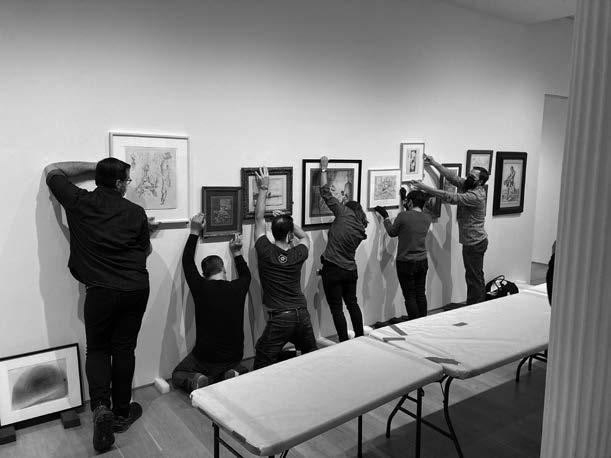
Now to the drawings—this first wall is a tribute to artists who have passed away this past year: Christo, Robert Bechtle, and Susan Rothenberg as well as Barry Le Va, whose work is in the back gallery. While each work on paper is interesting in itself, when you connect them physically, they become interdependent, making the groupings more dynamic. It brings the works alive in a new and different way. Installing works so that their frames touch is an unusual strategy for exhibition making. To me, the forced connection between works based on their placement creates connections that are meaningful and visually exciting.



This next wall includes both famous and lesser-known artists. To the far left is a watercolor by LA artist Aaron Morse, and at the far right is an Andy Warhol Skull next to an amazing Charles Demuth still life. Demuth is probably one of the greatest watercolorists in the pantheon of American artists. This is a work you need to study up close to see how he applied the watercolor: to appreciate what he left untouched and what he chose to focus on. I juxtapose it with the Warhol to create a meditation on death, or vanitas. Placing the skull next to these ripe fruits and flowers that are going to wither and die creates a different narrative from what you would have if the drawings were viewed separately. In this group, I also make a connection between Rashid Johnson and Cy Twombly. There’s a quality to Johnson’s mark making that is reminiscent of Twombly’s later work. Twombly moves from discrete marks to big rhythmic gestures—and I see that with Rashid Johnson as well. Next to the Twombly is a work by Julie Mehretu, who is known for dense and layered compositions. This drawing on Mylar is like an explosion or a manifestation of energy.
As we move to the neighboring wall—which is primarily a wall of abstraction—we have Brice Marden, Sol LeWitt, Jasper Johns, and Agnes Martin. The Jasper Johns, which is also on Mylar, has a kind of grid that sits over its subject. When you look closely, there are drips across the image, which you can tell are very controlled: they come
up from the bottom, the side, and down from the top of the paper. It is a beautiful surface and masterful use of material.
Following from there, we have a group of works that are hung with the tops of the frames touching. These portraits, which represent various interpretations of the female form, range in date from a beautiful eighteenth-century drawing by François Boucher to the most contemporary piece in the group, which is by Chris Ofili from 2005.

A particular love of mine and highlight of the collection are Pre-Raphaelite artists and those influenced by the brotherhood. Drawings from this group are well represented in this installation and include a Edward Burne-Jones and a Simeon Solomon as well as a piece by one of the only female artists associated with the PreRaphaelites, Mary Evelyn De Morgan, about whom I only recently learned.
To the left of the De Morgan is an 1880s study of a seated lady with a hat by Adolf von Menzel. You can see how incredibly articulated it is on the one hand and at the same time, in the lower left, the marks become almost like an Abstract Expressionist drawing.
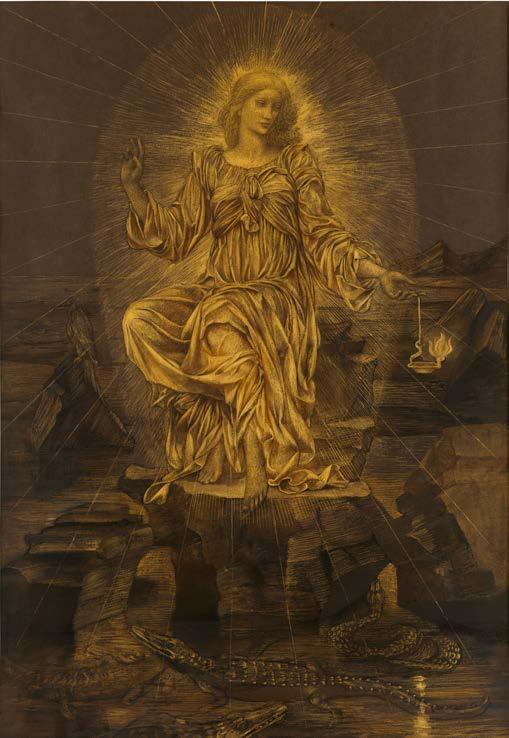 JS 437 Evelyn De Morgan, The Light Shineth in the Darkness and the Darkness Comprehended It Not, c. 1895
JS 437 Evelyn De Morgan, The Light Shineth in the Darkness and the Darkness Comprehended It Not, c. 1895

 JS041 Pablo Picasso, La fille de la Marquise de Villarrautia (The Daughter of the Marquise de Villarrautia), 1918.
JS041 Pablo Picasso, La fille de la Marquise de Villarrautia (The Daughter of the Marquise de Villarrautia), 1918.
There is also a Roy Lichtenstein from 1963 that depicts a woman on the phone saying, “Oh Jeff…I love you too…but....” It’s a beautiful example of an early Lichtenstein, and it’s a great, great drawing. I had the honor of knowing him personally, which makes it even more special.
Last year, when I hung the exhibition Drawn: From the Collection of Jack Shear at the Blanton Museum in Austin, Texas, I also included a portrait by Picasso from 1918 in the female group, which will be included in Take Three of Ways of Seeing in Jarrett Earnest’s installation. The drawing was made about ten years after Picasso developed Cubism with Braque. With this piece, Picasso reminds us that he can draw in a formal, essentially academic way, almost as if he were referencing Ingres when he made it (he probably was).
Next, we have a group of drawings by Blinky Palermo, Vija Celmins, Lee Lozano, Lee Bontecou, Stella Snead, Sean Ryan, and Ed Ruscha. The Ruscha is called Two Sheets with Whisky Stains. It’s a perfect drawing for a works on paper collector: two sheets of blank white paper on a sheet of paper.

 JS052 Ed Ruscha, Two Sheets with Whisky Stains, 1973
JS052 Ed Ruscha, Two Sheets with Whisky Stains, 1973
Now let’s move to a wall that features depictions of the male form. These drawings appear installed as if they were sitting on a shelf with the frames aligned at the bottom instead of the top. Perhaps the most famous drawing on this wall, or the one that most people respond to, is the portrait of Alexis-René Le Go by Jean Auguste Dominique Ingres from 1836. Le Go served as Ingres’s secretary when he was director of the French Academy in Rome. The portrait depicts Le Go in front of the loggia at the Villa Medici in Rome, which remains home to the French Academy to this day. When I hung this series at the Blanton Museum, I also included a Marsden Hartley Self-Portrait from 1908 in which he looks really pained (his work is in the back room at The Drawing Center). He never thought he was attractive, and he hated self-portrait drawings, but this one is close to my heart. Next to the Hartley is this beautiful Giovanni Battista Piazzetta from around 1715. Piazzetta was one of the first Italian artists who made drawings that were intended to sell. He understood that drawings have as much emotional impact as paintings.

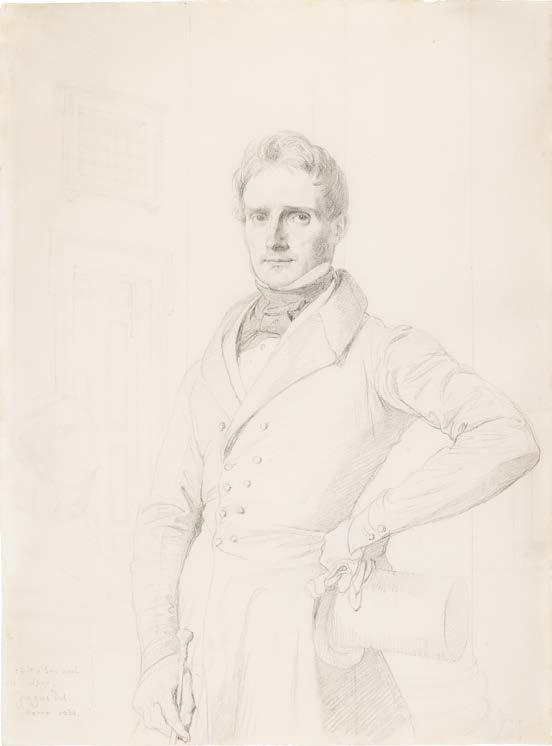 JS075 Jean-Auguste-Dominique Ingres, Portrait of Alexis-René Le Go, 1836.
JS075 Jean-Auguste-Dominique Ingres, Portrait of Alexis-René Le Go, 1836.
 JS145 Marsden Hartley, Self-portrait #11, c. 1908
JS145 Marsden Hartley, Self-portrait #11, c. 1908
 JS021 Giovanni Battista Piazzetta, A nude youth sprawled on his back, upon a bank, lying on a standard..., c. 1720
JS021 Giovanni Battista Piazzetta, A nude youth sprawled on his back, upon a bank, lying on a standard..., c. 1720
In the second gallery, I created a wall of predominantly blackand-white abstraction, which includes pieces by Richard Tinkler Hermann Nitsch, Barnett Newman, Minoru Onoda, Joe Yetto, Gerhard Richter, Donald Judd, and David Smith. To give the illusion that the group could go on forever, I installed the works all the way to the corner edges of the wall. Here, as throughout, the installations aim to create a stimulating and often unexpected dialogue between disparate works—across geography, subject matter, and time. As Picasso said, “I do not seek, I find.”
I’ve always collected. Even as a child, growing up in California, I had rock collections and bottle collections and a doorknob collection. I bought my first daguerreotype when I was 15 or 16 from a little shop that had twenty or so for sale. They were five dollars each, so I decided to buy five. The owner was dumbfounded: who is this teenager spending his money on daguerreotypes? I think he was pleased though, because he charged me twenty dollars for the five, giving me one for free. Daguerreotypes are printed on silver and often presented in small cases that have gold frames with glass inside. The cases themselves can be beautiful, and it is magical when you open them to reveal the image on silver. I went back to that same shop a couple of months later to buy the rest of the daguerreotypes, but they had all been sold. The owner told me that an old lady bought
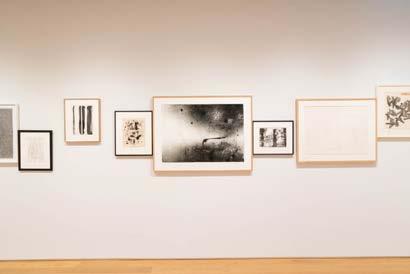
the rest of them, threw out the daguerreotypes, and put pictures of her cats and dogs in the frames.

That experience started me on the path to collecting the way that you tend to think about collecting historically—in the same voracious way others have put together great collections, whether it’s drawings, paintings, sculpture, furniture, design, books, or anything else. There’s a hunger for acquiring that most people don’t have, or don’t want to have—collectors are often insatiable.
Ultimately, it’s really about the pleasure of seeing, the pleasure of looking.
Works in the Exhibition
David Hockney
Man Drawing, 1965
Black ink on paper
10 x 12 1/2 inches (25.4 x 31.8 cm)
Christo
Packed Public Building (Project for Allied Chemical Tower, No. 1 Times Square in NYC), 1968
Graphite, wax crayon, charcoal, brush, and gray wash on paper
28 x 22 inches (71.1 x 55.9 cm)
Robert Bechtle
RB on De Haro Street, 2004
Charcoal on paper
12 1/2 x 12 1/2 inches (31.8 x 31.8 cm)
Susan Rothenberg
Untitled, 1979
Acrylic, vinyl paint, color pencil, and graphite on paper
23 x 19 inches (58.4 x 48.3 cm)
Richard Tuttle
No. 83 Two Black Lines, Three Grey Dots, 1973
Ink and watercolor on paper
8 3/4 x 6 inches (22.2 x 15.2 cm)
Alexander Calder
Three in the Middle, 1931
Black ink and transparent watercolor on paper
30 1/2 x 22 5/8 inches (77.5 x 57.5 cm)
Larry Poons
Untitled, c. 1961
Pencil on graph paper
8 1/4 x 11 inches (21 x 28 cm)
Fred Tomaselli
Ursa Major (May 12, 1991), 1991
Opaque watercolor and white chalk on paper
8 1/4 x 11 1/4 inches (21 x 28.6 cm)
Jean-Auguste-Dominique Ingres
Roger Freeing Angelica, c. 1830s
Pencil on tracing paper, squared in pencil
18 7/8 x 15 inches (47.7 x 38.2 cm)
Sigmar Polke
Ohne Title (Umarmung), [Untitled (Embrace)], 1963
Ballpoint pen on paper
11 5/8 x 8 1/4 inches (29.5 x 21 cm)
Guercino (Giovanni Francesco Barbieri)
Angelica and Medoro, c. 1640
Brown ink on paper
10 x 11 1/2 inches (25.4 x 29.2 cm)
Carlo Maria Mariani
Eliadi, 1981
Pencil on paper
19 x 14 inches (48.3 x 35.6 cm)
Léon Spilliaert
L’élévation, 1910
Pencil, ink wash, and brush on paper
11 15/16 x 7 11/16 inches (30.3 x 19.5 cm)
Bernard Boutet de Monvel
Erotic Scene, 1940
Pencil on paper
21 5/16 x 18 7/16 inches (54.2 x 46.8 cm)
Tom Knechtel
Working Drawing #1 for “Servant of Two
Masters”, c. 1993
Graphite on paper
16 1/2 x 13 3/4 inches (41.9 x 34.9 cm)
Raymond Pettibon
No Title (Whatever death means), 1990 Brown ink and transparent watercolor on paper
17 3/4 x 13 1/2 inches (45.1 x 34.3 cm)
Unknown (Indian School)
Sikh, n.d.
Pencil with gouache highlights on paper
6 1/4 x 3 1/8 inches (15.9 x 7.9 cm)
Walter Price
Scarecrow, 2020
Graphite, gel pen, Scotch tape, burned paper, colored pencil, and Sharpie on manila tagboard paper
12 x 9 inches (30.5 x 22.9 cm)
Jean-Auguste-Dominique Ingres
Portrait of Alexis-René Le Go, 1836
Graphite on paper
11 7/8 x 8 3/4 inches (30.2 x 22.2 cm)
Tom of Finland (Touko Laaksonen)
Untitled, 1980
Graphite on paper
12 x 8 7/8 inches (30.5 x 22.5 cm)
Giovanni Battista Piazzetta
A nude youth sprawled on his back, upon a bank, lying on a standard..., c. 1720 Black and white chalk on paper
20 x 15 inches (50.8 x 38.1 cm)
Robert Corless
Untitled (Self-Portrait), 1963
Pencil and collage on paper
11 x 9 inches (27.9 x 22.9 cm)
Elaine de Kooning
Portrait of Bill, 1950
Brown ink on paper
8 1/2 x 11 inches (21.6 x 27.9 cm)
Chris Ofili
Afromuses (Couple), 2005
Watercolor and pencil on paper, one of a pair on facing walls
19 x 12 1/2 inches (48.3 x 31.8 cm)
Henri Matisse
Marocain, mi corps (Moroccan, Bust Length), 1912–13
Graphite on paper
10 x 7 1/2 inches (25.4 x 19.1 cm)
R. Crumb
R. CRUMB by R. CRUMB, 2020
Pen, ink, and white paint on paper
11 3/4 x 8 7/8 inches (29.8 x 22.5 cm)
Paul Thek
Self-Portrait, c. 1969
Graphite on paper
10 5/8 x 7 3/4 inches (27 x 19.7 cm)
Otto Greiner
Back View of a Standing Male Nude, 1896 Black and red chalk and opaque watercolor on paper
18 1/8 x 11 3/8 inches (46 x 28.9 cm)
Blinky Palermo
Komposition weiss-weiss (Composition White-White), 1966
Graphite and tape on paper
11 3/4 x 8 1/4 inches (29.8 x 21 cm)
Lee Lozano
No Title, 1964
Graphite on paper
12 3/4 x 8 1/2 inches (32.4 x 21.6 cm)
Vija Celmins
Galaxy (Hydra), 1974
Graphite on acrylic ground on paper
12 x 14 7/8 inches (30.5 x 37.8 cm)
Lee Bontecou
Untitled, 1968
Soot, graphite, opaque watercolor, and white chalk on paper
28 1/2 x 22 1/2 inches (72.4 x 57.2 cm)
Stella Snead
Untitled, c. 1940s
Ink on paper
11 x 13 3/4 inches (27.9 x 34.9 cm)
Sean Ryan
Untitled, 2020-21
Silverpoint on paper
11 x 15 inches (27.9 x 38.1 cm)
Ed Ruscha
Two Sheets with Whisky Stains, 1973
Gunpowder and Scotch whisky on paper
14 9/16 x 22 13/16 inches (37 x 57.9 cm)
Bruce Conner
UNTITLED: JUNE 4, 1965, 83 FRANCIS ST., BROOKLINE, MA, 1965, 1999
Black ink on paper
19 7/8 x 9 1/4 inches (50.5 x 23.5 cm)
Robert Delaunay
La Tour Eiffel (The Eiffel Tower), 1911
Brown ink and graphite on paper
18 1/4 x 15 1/4 inches (46.4 x 38.7 cm)
Anne-Louis
Girodet de Roussy-Trioson
Héro et Léandre, c. 1800
Pen, brush, brown ink, ink wash, and white gouache on blue paper
8 5/8 x 7 1/8 inches (21.9 x 18.1 cm)
Georges Seurat
An Evening, Gravelines, 1890
Conté crayon on paper
9 3/8 x 12 3/8 inches (23.8 x 31.4 cm)
François André Vincent
Arria and Paetus, c. 1784
Brown and black ink, black and red chalk on paper
16 1/4 x 19 3/4 inches (41.3 x 50.2 cm)
Fernand Legér
Etude pour “La Gare” (Study for “The Train Station”), 1918
Graphite on paper
9 1/2 x 13 5/8 inches (24.1 x 34.6 cm)
Georges Braque
La Guitare (The Guitar), 1919
Charcoal, pencil, and crayon on paper
10 5/8 x 8 inches (27 x 20.3 cm)
Eugene Delacroix
St. Sebastian Tended by the Holy Women, 1852–54
Pastel on paper
7 1/8 x 10 3/8 inches (18.1 x 26.4 cm)
Théodore Rousseau
Landscape in the Auvergne, c. 1830
Graphite and opaque watercolor on paper
11 1/2 x 8 3/4 inches (29.2 x 22.2 cm)
Jean-Baptiste-Camille Corot
The Forum with the Temple of Venus in Rome, 1825
Graphite on paper
6 3/4 x 13 5/8 inches (17.1 x 34.6 cm)
Pierre Puvis de Chavannes
Study for Doux Pays, 19th Century Black crayon and watercolor on paper
7 3/4 x 12 1/8 inches (19.7 x 30.8 cm)
Jacques Quesnel
Time Fighting Youth, c. 1588
Pen and brown ink
19 1/4 x 15 1/4 inches (48.9 x 38.7 cm)
Walter Sickert
Portrait of Carolina in A Shawl, c. 1904
Charcoal with white chalk on gray paper
16 1/2 x 9 3/4 inches (41.9 x 24.8 cm)
Ernst Ludwig Kirchner
Reclining Female Nude, c. 1915
Graphite on paper
12 3/16 x 18 9/16 inches (31 x 47.1 cm)
Jim Nutt
Untitled, 2005
Graphite on paper
15 x 14 inches (38.1 x 35.6 cm)
John D. Graham
Head of a Young Woman, 1944
Silverpoint and graphite on paper
9 1/2 x 9 1/2 inches (24.1 x 24.1 cm)
Chris Ofili
Afromuses (Couple), 2005
Watercolor and graphite on paper, one of a pair on facing walls
19 x 12 1/4 inches (48.3 x 31.1 cm)
Adolph Friedrich
Erdmann von Menzel
Studie einer sitzenden Dame mit Hut, Schirm und Geldbörse (Study of a Seated Woman with a Hat, Umbrella and Coin Purse), 1880
Graphite on paper
8 x 5 inches (20.3 x 12.7 cm)
Evelyn De Morgan
The Light Shineth in the Darkness and the Darkness Comprehended It Not, c. 1895 Black and gold chalk with graphite on paper
25 x 17 1/2 inches (63.5 x 44.5 cm)
François Boucher
Head of a Young Woman, c. 1754
Black and white chalk on paper
13 7/8 x 9 7/8 inches (35.2 x 25.1 cm)
Roy Lichtenstein
Oh, Jeff...I Love You, Too...But...(Study), 1964
Colored pencil and graphite on paper
5 3/4 x 5 5/8 inches (14.6 x 14.3 cm)
Oskar Kokoschka
Reclining Female Nude, c. 1911–12
Charcoal and crayon on paper
12 1/2 x 16 11/16 inches (31.8 x 42.4 cm)
Edward Coley Burne-Jones
S. Mary Magdalene the Morning of the Resurrection, 1886
Graphite on paper
12 x 7 inches (30.5 x 17.8 cm)
Simeon Solomon
Queen Esther Hearing the News of the Intended Massacre of the Jews, 1860
Pen and ink with some lead white on paper main sheet with three narrow additions laid to board
11 1/4 x 13 3/4 inches (28.6 x 34.9 cm)
Jean Arp
Untitled, 1918–20
Collage and paint on paper
13 3/4 x 13 inches (34.9 x 33 cm)
Joan Miró
Métamorphoses (Metamorphosis), 1936
Black ink, watercolor, charcoal, collage, and decal on paper
18 7/8 x 25 1/4 inches (47.9 x 64.1 cm)
Anne Ryan
M1044D#183, c. 1950
Collage on cardboard
7 1/2 x 6 inches (19.1 x 15.2 cm)
James Rosenquist
Study for Marilyn Monroe, 1962
Collage, color pencil, and graphite on paper
11 1/4 x 13 1/16 inches (28.6 x 33.2 cm)
Kurt Schwitters
für Herrn Dr. Bode (For the Gentleman Dr. Bode), 1924
Collage on artist mount
13 9/16 x 10 7/8 inches (34.4 x 27.6 cm)
Joe Brainard
Infant of Prague with Flowers, 1966
Gouache and collage on paper
14 x 11 inches (35.6 x 27.9 cm)
Terry Winters
Untitled, 2018
Graphite on paper
8 1/2 x 11 inches (21.6 x 27.9 cm)
Unknown (Indian School)
Tantric Drawing, c. 2000
Gouache and/or pigment and ink on paper
11 1/4 x 5 1/2 inches (28.6 x 14 cm)
Kalu Ram
Chart of 56 Shaligrams, n.d. Ink and gouache on paper with collage
28 x 21 inches (71.1 x 53.3 cm)
Jasper Johns
Untitled, 2015 Black ink on plastic
30 x 27 inches (76.2 x 68.6 cm)
Sol LeWitt
Red Grid, Yellow Circles, Black Arcs from Four Sides and Blue Arcs from Four Corners, 1972
Ink and graphite on paper
17 x 17 inches (43.2 x 43.2 cm)
Agnes Martin
Untitled, c. 1975
Transparent watercolor, black ink, and graphite on paper
9 x 9 inches (22.9 x 22.9 cm)
Brice Marden
Untitled, 1971
Graphite on paper
28 7/8 x 20 3/4 inches (73.3 x 52.7 cm)
Aaron Morse
Wilderness, 2000
Watercolor on paper
15 1/2 x 21 3/4 inches (39.4 x 55.2 cm)
Rashid Johnson
Untitled Anxious Red Drawing, 2020
Oil on cotton rag
30 x 22 inches (76.2 x 55.9 cm)
Cy Twombly
Untitled, 1959–63
Pencil, ink, and crayon on paper
19 3/4 x 27 1/2 inches (50.2 x 69.9 cm)
Julie Mehretu
Untitled, 2000
Ink and colored pencil on vellum laid on paper
19 x 24 inches (48.3 x 61 cm)
Charles Demuth
Fruit and Flower, c. 1925
Opaque and transparent watercolor and graphite on paper
12 x 18 inches (30.5 x 45.7 cm)
Andy Warhol
Skull, c. 1976
Graphite on paper
20 1/2 x 28 inches (52.1 x 71.1 cm)
Pablo Picasso
Étude pour “Déjeuner sur l’herbe” II
(Study for “Luncheon on the Grass” II), 1962
Graphite on paper
10 5/8 x 13 7/8 inches (27 x 35.2 cm)
Bruce Nauman
A Rose Has No Teeth / Lead or bronze
plaque to be attached / to a tree in the woods so that it will / be grown over, 1966
Graphite on paper
18 7/8 x 24 inches (47.9 x 61 cm)
Claes Oldenburg
Drainpipe Study, 1967
Opaque and transparent watercolor and crayon on paper
30 x 22 inches (76.2 x 55.9 cm)
Robert Morris
Study for 4” Interlocking Brass Rings, 1968
Opaque and transparent watercolor and graphite on graph paper
25 3/4 x 30 1/2 inches (65.4 x 77.5 cm)
Pavel Tchelitchew
Portrait of Charles Henry Ford, c. 1940 Brown and blue ink on paper
11 3/4 x 7 7/8 inches (29.8 x 20 cm)
Mark Tobey
Lights, 1954
Tempera on Japan mounted on card
8 1/2 x 17 3/4 inches (21.6 x 45.1 cm)
Guercino (Giovanni Francesco Barbieri)
Lucretia, c. 1638
Pen and brown ink
5 11/16 x 4 13/16 inches (14.4 x 12.2 cm)
Odilon Redon
La Terrible (The Terrible One), c. 1871
Charcoal and black chalk on paper
16 3/4 x 13 1/4 inches (42.5 x 33.7 cm)
Alice Neel
Requiem, 1928
Watercolor on paper
9 x 12 inches (22.9 x 30.5 cm)
Edvard Munch
Blødende hjerte (Bleeding Heart), c. 1898
Crayon and opaque and transparent
watercolor on paper
9 7/8 x 14 1/8 inches (25.1 x 35.9 cm)
Günter Brus
Die rote Tödin, 1981
Pastel and graphite on packing paper
47 7/8 x 31 1/2 inches (121.6 x 80 cm)
Ellsworth Kelly
Blue Cut Out, 1962
Gouache on paper on paper cutout
12 1/8 x 9 inches (30.8 x 22.9 cm)
Joaquín Torres-García
Composición (Composition), 1930
Black ink and graphite on paper
5 1/4 x 3 1/2 inches (13.3 x 8.9 cm)
Albert Oehlen
Untitled, 2009
Black ink, graphite, plastic, and collage on paper
11 3/4 x 10 3/4 inches (29.8 x 27.3 cm)
Fred Sandback
Untitled 3/11/74, 1974
Pastel on paper
23 x 29 inches (58.4 x 73.7 cm)
Dorothy Dehner
Family Group 1, 1954
Ink on paper
23 1/4 x 35 inches (59 x 88.9 cm)
Barry Le Va
Untitled (Animated Perspective), 1981–82
Black ink, acrylic, and graphite on paper
22 1/4 x 13 inches (56.5 x 33 cm)
Torkwase Dyson
Sing, 2020
Gouache and ink on paper
16 x 12 inches (40.6 x 30.5 cm)
Joel Shapiro
Untitled, 1978
Charcoal on paper
18 x 18 inches (45.7 x 45.7 cm)
Willem de Kooning
Figure on a Beach, 1958
Black ink on paper
17 x 14 inches (43.2 x 35.6 cm)
Richard Serra
C.C. XI, 1983–84
Oilstick on paper
38 x 52 inches (96.5 x 132.1 cm)
Terry Winters
Untitled, 2011
Graphite on paper
19 7/8 x 25 1/2 inches (50.5 x 64.8 cm)
Richard Tinkler
Book 5, Vol. 1, Page 7 - (1,2,1,2,1,2), 2020
Color ink on paper
23 1/4 x 17 3/4 inches (59.1 x 45.1 cm)
Hermman Nitsch
Untitled, 1973
Black ink and graphite on paper
11 3/4 x 8 1/4 inches (29.8 x 21 cm)
Barnett Newman
Untitled, 1960
Black ink on paper
14 x 10 inches (35.6 x 25.4 cm)
Minoru Onoda
Untitled, 1962
Ink on paper
13 3/4 x 10 5/8 inches (34.9 x 27 cm)
Joe Yetto
Untitled, 2010
Charcoal on paper
29 1/2 x 41 1/2 inches (74.9 x 105.4 cm)
Gerhard Richter
Abstract VII 91, 1991
Ink on paper
9 1/4 x 13 inches (23.5 x 33 cm)
© Gerhard Richter 2021
Donald Judd
Plywood Angled Boxes, #280, 1976
Graphite on paper
22 3/4 x 31 inches (57.8 x 78.7 cm)
David Smith
Untitled, 1955
Egg ink and tempera on paper
17 3/4 x 22 1/2 inches (45.1 x 57.2 cm)
Gordon Matta-Clark
Untitled (Arrows), 1973–74
Graphite on paper
17 1/2 x 23 1/2 inches (44.5 x 59.7 cm)
Andy Warhol
Mao, 1973
Graphite on paper
40 x 30 inches (101.6 x 76.2 cm)
Marsden Hartley
Self-portrait #11, c. 1908
Black crayon on paper
12 x 9 inches (30.5 x 22.9 cm)
Philip Guston
Head and Smoke, 1974
Black ink on paper
18 7/8 x 23 5/8 inches (47.9 x 60 cm)
Patrick Lee
Deadly Friends (Bubba), 2009
Graphite on paper
36 x 24 inches (91.4 x 61 cm)
Jasper Johns
Handprint, 1964
Oil on paper
20 5/16 x 17 1/4 inches (51.6 x 43.8 cm)
Robert Rauschenberg
Untitled, 1965
Solvent transfer, graphite, crayon, watercolor, and paint on paper
14 1/8 x 20 inches (35.9 x 50.8 cm)
Vija Celmins
Untitled (Ocean), 2014
Charcoal on acrylic ground on paper
15 1/4 x 18 1/2 inches (39 x 47 cm)
Nancy Grossman
Sketch #1 for Bound, 1975
Lithographic crayon and wash on coated paper
29 x 19 1/2 inches (73.7 x 49.5 cm)
Nancy Spero
The Bomb, 1966
Gouache and ink on paper
16 1/2 × 22 inches (41.9 × 55.9 cm)
George Grosz
Stammgäste (Regular Guests), 1915
Black ink on paper
12 5/8 x 8 1/16 inches (32.1 x 20.5 cm)
Max Beckmann
Entkleidetes Café, 1944
Ink and india ink on paper
10 5/8 x 14 1/2 inches (27 x 36.8 cm)
Julian Schnabel
Untitled (Automatic 6:30-8:30, 4.9. E - 68), c. 1980
Blue ink and graphite on paper
16 x 13 inches (40.6 x 33 cm)
Francis Picabia
Transparence (Transparency), c. 1930–33
Pencil, color pencil, and ink on paper
14 1/4 x 12 1/4 inches (36.2 x 31.1 cm)
Georg Baselitz
Der neue Typ (The New Type), 1966–67 Charcoal, watercolor, and graphite on paper
24 x 17 inches (61 x 43.2 cm)
Jan Toorop
Meditatie (Meditation), 1921 Black crayon on paper
11 3/8 x 9 inches (28.9 x 22.9 cm)
Fernand Khnopff
Study for The Blood of Medusa, 1898 Graphite, crayon, and collage on wove paper
8 3/8 x 6 3/8 inches (21.3 x 16.2 cm)
Giorgio Morandi
Natura Morta (Still Life), 1959
Watercolor on paper
9 1/4 x 6 3/4 inches (23.5 x 17.1 cm)
Hilaire-Germain-Edgar Degas
A Study of a Young Boy with his Arms Raised about his Head, Preparatory for ‘Young Spartans Excercising’, c. 1860 Graphite on paper
14 x 8 3/4 inches (35.6 x 22.2 cm)
Hashimoto Sadahide (Utagawa Sadahide)
The Opposing Forces Ford a River Towards Troop in Formation on Bank (Preparatory drawing for a triptych of a battle scene), c. 1847–48
Black ink on paper
15 x 19 1/2 inches (38.1 x 49.5 cm)
Kim Jones
Untitled, 1996 Pencil on paper
25 x 38 inches (63.5 x 96.5 cm)
Jean-Honoré Fragonard
The miraculous draught of Ruggiero and Alcina (Orlando furioso, VII, 32), c. 1780–85
Black chalk with opaque and transparent watercolor on paper
15 7/8 x 10 1/4 inches (40.3 x 26 cm)
André Masson
Sémiramis et le Minotaure (Semiramis and the Minotaur), 1940 Black ink on paper
18 3/4 x 24 5/8 inches (47.6 x 62.5 cm)
Kota School, North India, Rajasthan Tiger Hunt with Elephants, late 19th Century Black ink, opaque and transparent watercolor, and red chalk on paper
20 1/2 x 18 7/8 inches (52.1 x 47.9 cm)
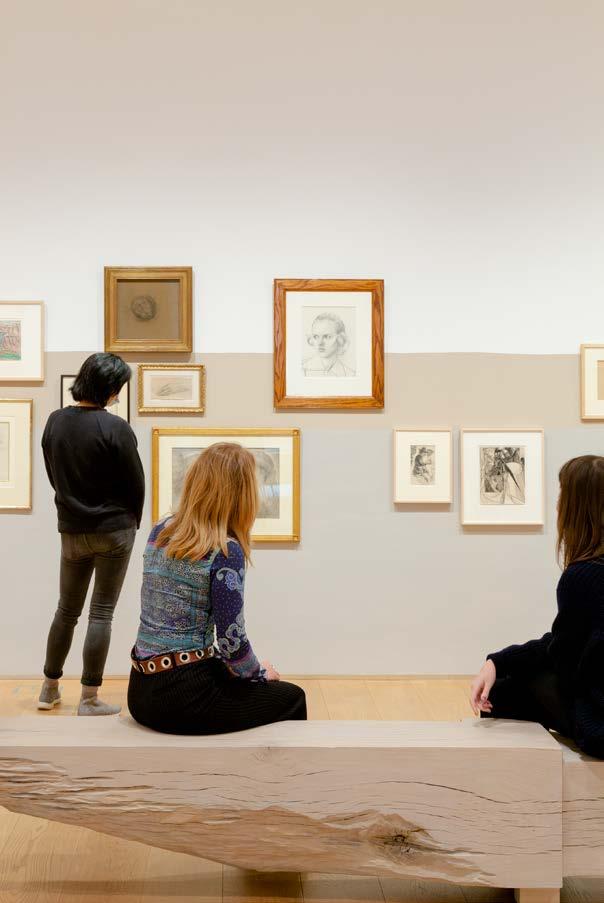 Arlene Shechet
Arlene Shechet
Drawings present unmediated evidence of the artist’s hand and mind. They stem from an intimate practice whose tools and materials are limited. They are essentially records of the body: of being alive. As surfaces that bear the rawest marks of one’s hand, drawings are by nature intimate objects that remind us of the important of touch. Since I conceived this show at the height of a pandemic that necessitated isolation from others, this issue of touch had double weight for me. I knew the drawings alone could stimulate an awareness of one’s body. But as a sculptor, I also knew the importance of space in shaping a viewing experience. How and where one stands in relation to an artwork is integral to how that artwork inherits meaning: how it is seen. Pulling out the drawings’ greatest potential meant connecting them to something outside of their own contours while allowing each one to independently hold its own. I wanted to play with the traditional viewing height and distance that one experiences in a gallery and have the room accommodate various body positions, inviting people to linger, have conversations, and possibly even sit together after months of being apart.
In contrast to the intimacy of the drawings, the space of The Drawing Center has a large central volume that can feel cavernous. As a sculptor, I was sensitive to this. Creating horizontal lines to fill the space and reach out to the walls would knit the room together. What could those lines be? Low-lying sculptures that would not interfere with viewing the drawings but would enhance the pleasure of experiencing the art. This connective tissue would eventually take the form of a quartet of hand-carved benches made from single logs of white oak. The massive nature of those bestial logs anchored and grounded the space and also provided a canvas
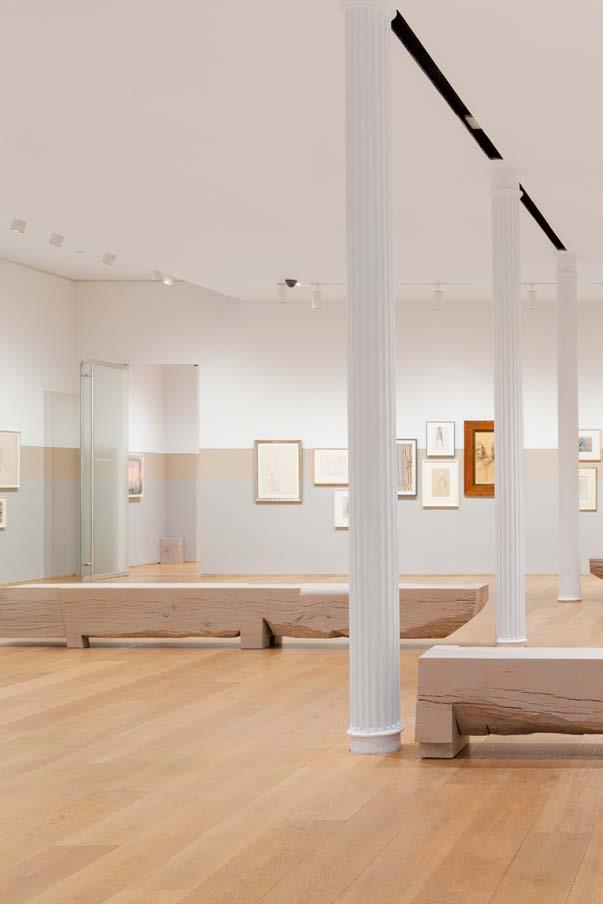
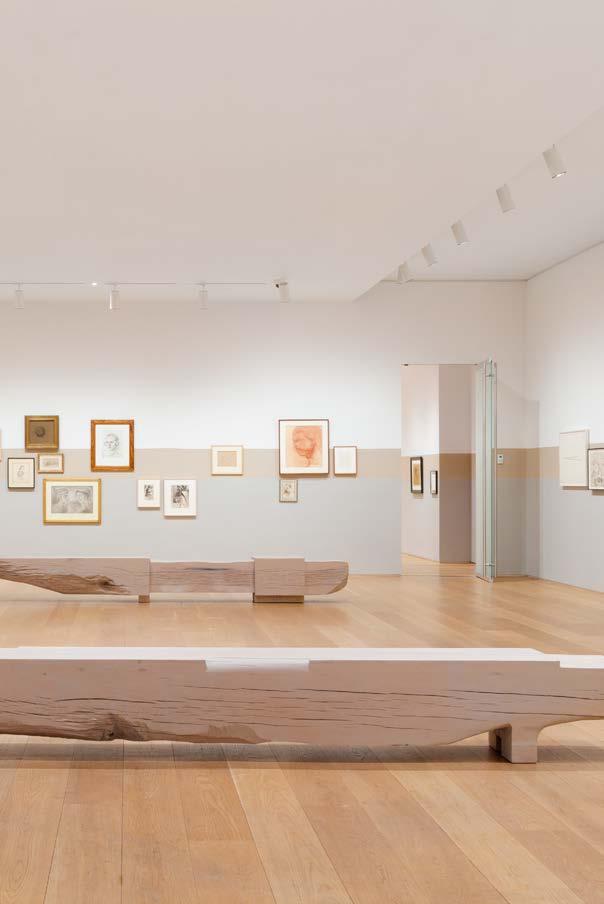

for me to carve my own lines that played off those of the works in Jack Shear’s collection. These horizontal structures also spoke to the fluted columns (the architectural equivalent of trees) in the main gallery of The Drawing Center. From a functional point of view, and given that the show opened as winter descended on New York, the benches gave people a place to gather and spend time with the work and with each other. [FIG. X]
In planning the show, I realized I needed to paint as well as carve. Seeing a show of Giorgio Morandi’s paintings at David Zwirner gallery made me conscious of space in a new way: all the forms are compacted, enclosed, grounded. He eliminated the space between the vessels and created a divided ground for them to live in. I wanted to carry this sensation to The Drawing Center, creating a space that would hold you close while looking and make you completely aware of your own presence [FIG X].
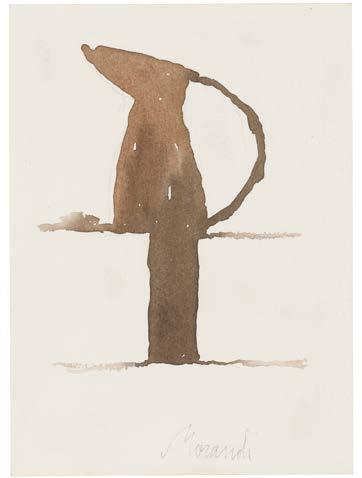 FIG JS275 Giorgio Morandi, Natura Morta, 1959.
FIG JS275 Giorgio Morandi, Natura Morta, 1959.


I took note of Morandi’s use of the horizon line to divide his compositions. Inspired, I decided to hand paint the lower register of the walls, dividing them into two unequal areas using lightly modulated earth tones, in order to create a palette and texture that could hold and unite the disparate elements of the show. I wanted to create a kind of architectural landscape on the walls within which I could play with the hanging of the artworks. The paint was brushed on by hand so that the color was not opaque or uniform, conveying the feeling of human touch. Morandi’s touch is so potent, and this same impression was reflected on the walls with brighter patches where the paint is thinner and the white wall shows through—the uneven work of the hand lending an overall dynamism.
Drawings reveal the imperfection of being human, complete with a wobbly hand that exerts irregular pressure across a surface. In a few drawing selections and placements, I pulled this unevenness out explicitly. The Jim Nutt Oh Look! and Look at this! drawings (1975), for instance, accentuate the painted line’s wonkiness as the crooked edge of the pages seem to extend directly into and onto the wall [FIGS X, X]. Throughout the show, I wanted to initiate a back-and-forth between looking closely at the interior of a drawing and then zooming out, seeing its relationship to the overall design of the room. In a room of such size, orchestrating this balance between different ways of looking and moving through the space was the challenge. Ideally, the drawings and architecture would create a constellation, where all the elements subliminally fire away, leading your eye and body through the space.
A curator may say I approached this whole project backwards, working first with the space and second with the objects in the space. But I see it more as a dance than a hierarchy or a fixed order of procedures. I follow this kind of improvisational logic in the studio and all other public spaces in which I’ve curated or created artwork. I am always guided by the materials at hand rather than some predetermined will I have for them—and as a sculptor, my materials necessarily involve the work’s final environment, not only the stuff in my studio. In this way, I saw myself in service to both the drawings and the specificity of The Drawing Center as a site for hanging them, knowing I wanted to create a completely integrated experience of them both. If I was successful, the drawings would stand as autonomous artworks and at the same time create a rhythm throughout the room, inviting a new way of moving and seeing for everyone who encountered them.
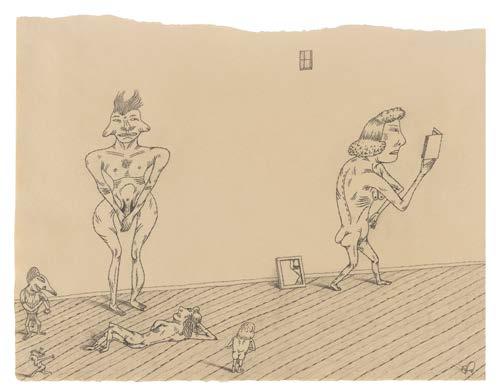
 FIG X, X JS340, 341
Top: Jim Nutt, Oh Look!, 1975 / Bottom: Jim Nutt, Look at this!, 1975
FIG X, X JS340, 341
Top: Jim Nutt, Oh Look!, 1975 / Bottom: Jim Nutt, Look at this!, 1975
The hanging process was necessarily action-oriented, since it all happened in two days. I intentionally came with more drawings than would fit, and I began spacing them out by hanging one piece on one wall and letting that dictate what came next. I quickly discovered that the process of hanging these drawings was the same process as making art and specifically the same as making my sculptures. It’s a 360-degree mentality, based on circulating around the object as it comes into being, dealing with all angles at once. It’s the opposite of linear thinking: working from the center outward. This happens not only when producing a single sculpture, but also when working on six or seven sculptures at a time, making moves on each piece, which over time develops a language across the whole group. The relationships unfold in real time. On some level I already knew this, but the experience of diving in at The Drawing Center—taking a leap of faith in the materials’ capacity to create new meaning—confirmed this. As the only artist in the triad of curators, I found myself using the same techniques and strategies I use every day in the studio.
In this spirit, I placed Gaston Lachaise’s Dancing Female Nude with Headdress (n.d.) as the centerpiece of the back room, letting

 JS050 George Grosz, Stehender Akt (Standing Nude), c. 1927–28.
JS050 George Grosz, Stehender Akt (Standing Nude), c. 1927–28.
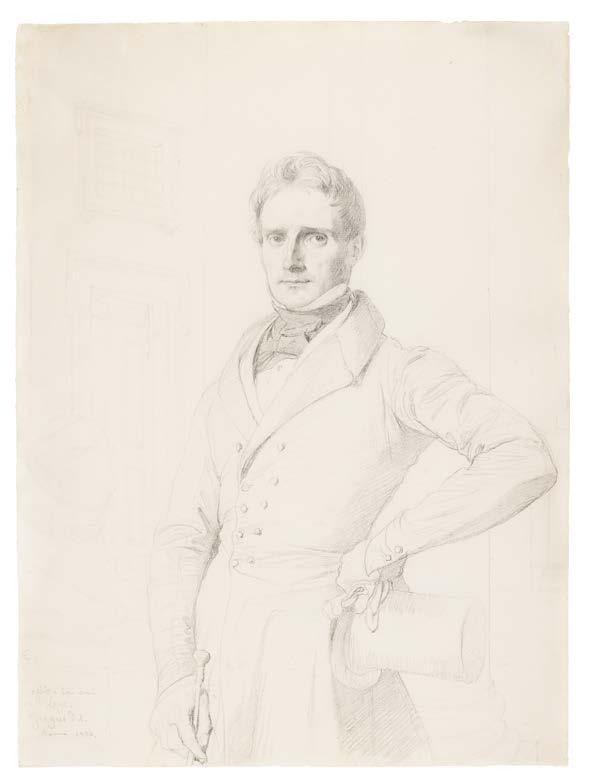 JS075 Jean-Auguste-Dominique Ingres, Portrait of Alexis-René Le Go, 1836.
JS075 Jean-Auguste-Dominique Ingres, Portrait of Alexis-René Le Go, 1836.
it dictate what followed around it [FIG X]. The figure’s breasts read to me like eyes, and from this unfolded the concept of a portrait gallery of sorts. While I did not generally select drawings based on their subject matter, in this room I instinctually developed a hanging strategy based loosely around this idea. All the drawings are hung so that the sitter’s eyes are at the same height. An imaginary line is thus drawn by their gaze—all except one, the fantastic Stehender Akt (Standing Nude, 1927–28) by George Grosz [FIG X] at the center, flanked on either side by “proper” men—Ingres’s contrite Portrait of AlexisRené Le Go (1836) [FIG X] and Raphael Soyer’s intent Self Portrait and My Father (n.d.) [FIG X]. The portraits are bookmarked on either side


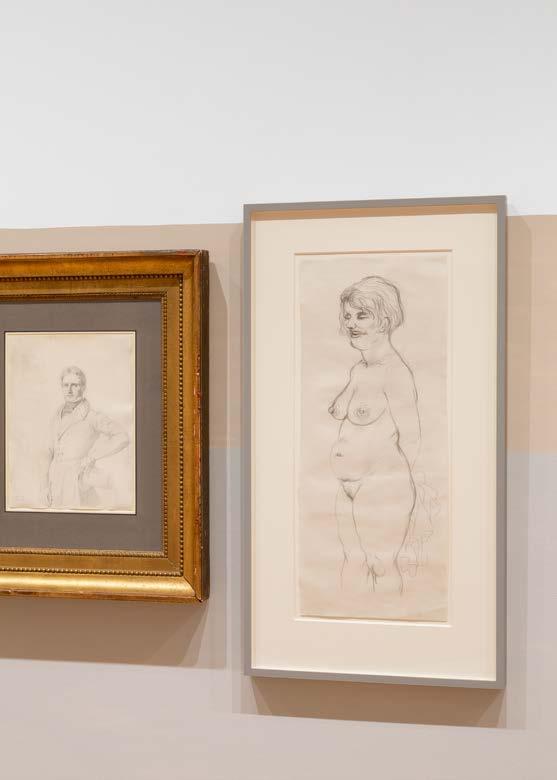

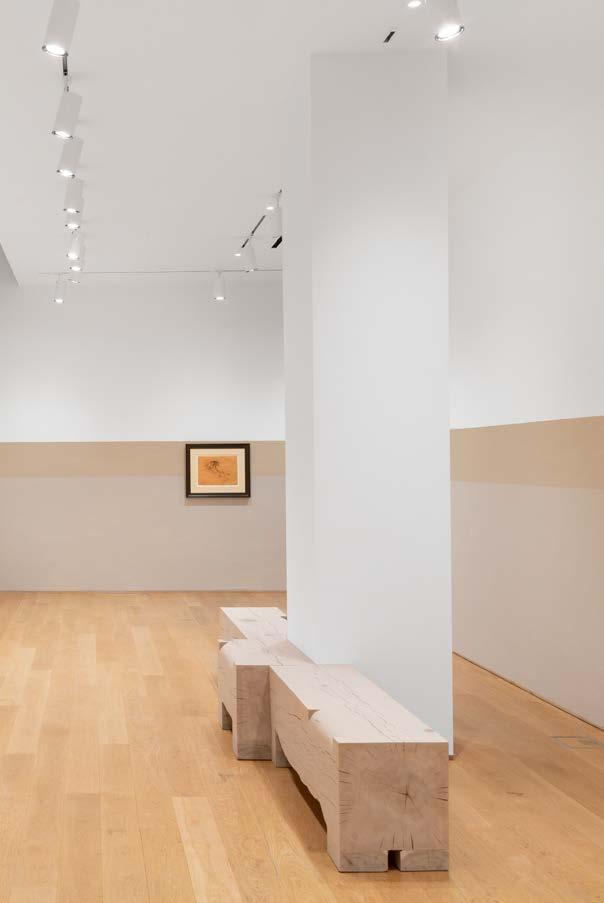
JS533 Kinke Kooi, Man, 2001
JS534 Kinke Kooi, Woman, 2001

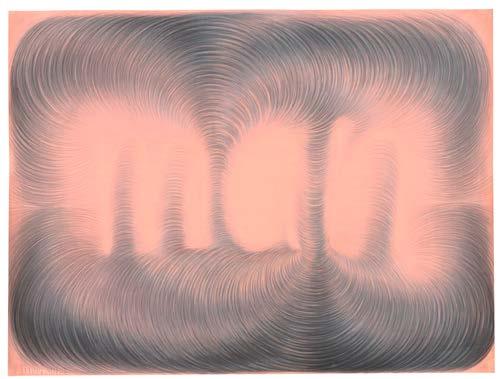
by reclining nudes and the incredible pencil drawings by Kinke Kooi that read “Woman” and “Man” [FIG X, X]. The symmetry created by this array of drawings was another way of organizing the space—and also a way to play with the idiosyncrasies of Jack’s collection. I loved discovering this range and a few outliers in what I thought I knew about an artist’s oeuvre.
This back room also posed a unique spatial problem. It is a narrow space, penetrated at its center by an uncomfortably bulky column. A problem is a great thing for an artist, though, usually prompting some idea that ends up defining the work. So I played into it, positioning the bench so that the obnoxious column literally “pushes” its center out, turning its formerly straight edge into a jagged one. This created a privileged viewing seat, a perch from which one could address the wall of sitters—specifically Lachaise’s “queen,” positioned directly in front of the makeshift throne. The
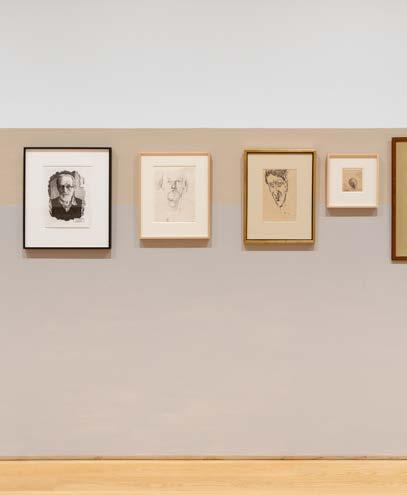
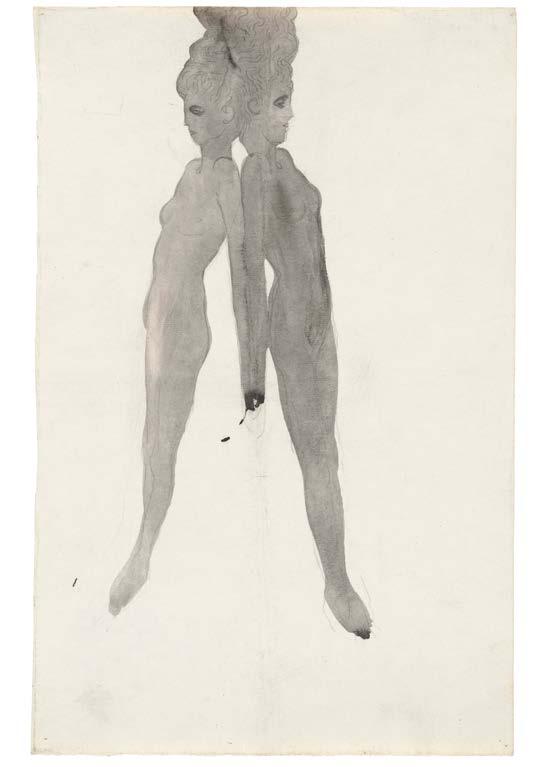 JS538 Léon Spilliaert, L’élévation (The Elevation), 1910
JS538 Léon Spilliaert, L’élévation (The Elevation), 1910
room is full of real personages and opens the notion of what a portrait can be.
Even though a hanging formula took shape in this back space, this is not how I approached the curatorial mandate in general. Like in the process of artmaking, I did not begin with rules, but instead let the drawings speak to me over the course of repeated viewings. It took six months before I even grasped the full breadth of the collection and another eighteen months of coming and going from the collection, pulling out connections between the works. It was a slow burn. Many of the connections were about gesture and mark, not “subject matter” per se. Ray Yoshida’s untitled graphic drawing of parting curtains [FIG XJS276] played off the amorphous strokes of Léon Spilliaert’s L’elevation, which looks like legs parting [FIG X, X]. Further down the wall, Pierre Puvis de Chavannes’s drawing, St. Radegonde Taking the Veil, activates the same gesture but in



an explicitly religious context [FIG X]. And finally, Degas’s literal depiction of legs, Étude pour “Alexandre et Bucéphale” (c. 1859–60) [Edgar Degas] placed on the register below, makes the gesture even more lucid but never pins it down as one thing—it is still always about the act of drawing. On the opposite wall, Delacroix leads to Darger, which leads to Jim Nutt—a string of artists covering a wide swath of art history and with seemingly oppositional focuses and intentions, yet who are connected by the act of drawing, the act of sitting down and making a mark. What connects Jim Nutt to Cy Twombly is not what they depict, but how they draw: that same nervous but sure hand. In making selections, I kept specific meaning from overriding the general attitude of what a drawing is and how the marks are made. [FIG X, X, X]
The benches further amplified my overall curatorial strategy. I conceived of them as both a place for sitting and a way to bind together the room. The connection is made through color but also through scale as the top register of the painted wall is the exact width of the benches. Of course, a viewer would not be specifically aware of this measurement but might subconsciously start to tie the planes together, essentially “flipping” the floor up to the wall and the wall down to the floor. The two registers complicate the notion of an “ideal” viewing height and a single horizon line. Standing upright, positioned close to the wall, the beige line meets the eye at a height of X inches. But sitting down and viewed from afar, the lower register is the one more related to the body, creating a second horizon line.
 JS199 Pierre Puvis de Chavannes, Left Hand, n.d.
JS199 Pierre Puvis de Chavannes, Left Hand, n.d.
JS144 Eugene Delacroix, St. Sebastian Tended by the Holy Women, 1852–54.

JS066 Henry Darger, At Cedernine. Vivian girls ... battle, but refuse to leave the field (recto) At Anna Miria. One of the Vivian girls Violet takes up afternoon sentry duty and frustrates a number of Glandelinian sharp shooters be her own swift and good accuracy of shooting (verso), c.1940–1960.

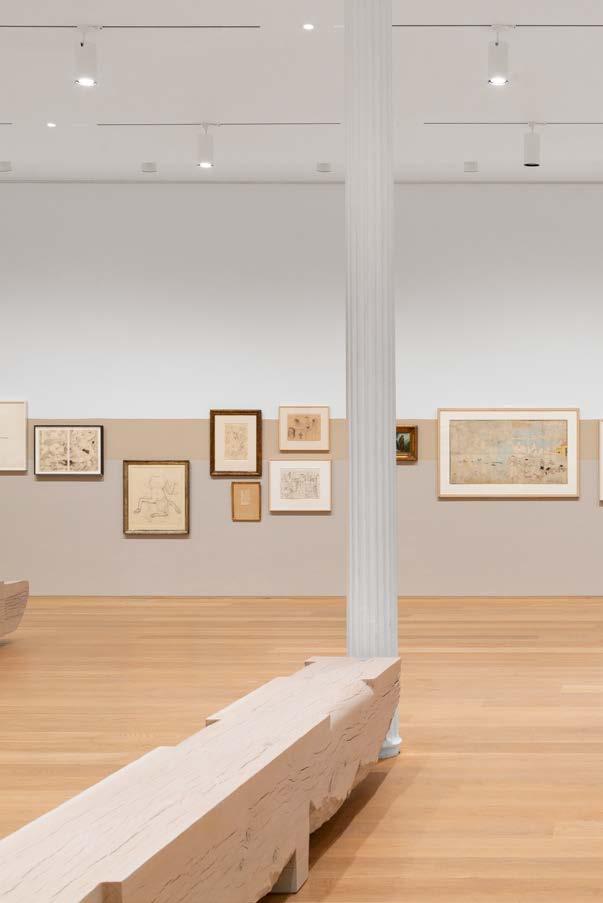

Nearly all the works hang low in the room, hugging this second, lower register—like a handrail supporting one’s body weight. I imagined the benches to be like logs or tree trunks that had fallen in the forest: nature’s most ingenious, ad hoc form of seating. As such, my carving intervention was actually quite minimal. I left the rawness of the wood intact, making sure that the brutish nature of the outdoors was not lost. I used a range of tools—some creating deep grooves, others shallow—so that every mark was distinct; yet the wood was not completely “tamed” by my hand. I conceived of its surface as yet another kind of drawing mark in the room. I also wanted all sides of the logs to be available for sitting, so I rounded the ends and created divots along the horizontal edges to suggest a seat. This did away with the front/back dichotomy of manufactured benches, allowing a person to reposition oneself along the log in any number of ways. [FIG X]
The benches were made from single, gargantuan trunks of white oak, which were dried for many months. This drying process is a bit like glazing in that there is a necessary surrender to the unknowns of chemistry and physics. While I can always predict how

the glazes might chemically react, I ultimately rescind control once the clay enters the kiln and is subjected to heat. In the case of white oak, which I have worked with for many years, I knew its general behavior of checking (expanding and cracking) during the drying process and had a premonition that long, straight lines would form as the wood expanded and contracted. But I could never know how this would play out exactly. I took joy in witnessing the wood making its own drawing as it cracked. Once I positioned the logs in the room, they created three bold, horizontal strokes, perpendicular to the columns, almost but not quite abutting them. Their straight fissures played off the more curvilinear contours in the floor’s finished planks, and of course the marks across each sheet of paper. Beyond the mark-making, I was drawn to the material synchrony of wood being the precursor to paper. While they are completely distinct in scale from what is on the walls, the logs created another kind of drawing—initiated by me but beyond my control.
I sensed a similar attitude of minimal intervention in the way Jack has approached his collection. Most of the drawings he has amassed have had past lives and previous owners who framed them and then lived with them. Regardless of condition, Jack has kept most of those frames intact, understanding their relationship to the drawing as a marriage—the drawing and frame: a single complete object. Toulouse-Lautrec’s Le Violiniste Dancla, for instance, with its nervous, sinewy line, feels intimately related to the peeling frame it sits in [FIG X]. This element was one of the great surprises I experienced while hanging, as my primary encounter with the drawings did not take their frames into account. During my visits to Jack’s collection, I took iPhone photos of the works, which I then printed and moved around like playing cards. The scale and condition of the frames were lost in this process, so it was only in the final stage of hanging that they became full objects to me again.
Likewise, I could not know until late in my own process how (or if) Jack’s installation would set the stage for mine. When I walked through his show, I experienced the drawings as autonomous objects—free from the conventional labels that would have placed each work in a certain time period or with a particular artist. Unhampered by art historical tradition, he gave himself permission to “DJ” the drawings according to some other visual logic. I embraced that attitude in my installation but made it more spatial. I felt compelled to deal equally with the architecture and the drawings so that all the elements—the walls, the floors, the columns, the drawings—would be experienced as an inevitable choreography, each
 JS564 Henri de Toulouse-Lautrec, Le Violiniste Dancla (The Violinist Dancla), n.d.
JS564 Henri de Toulouse-Lautrec, Le Violiniste Dancla (The Violinist Dancla), n.d.
part inseparable from the next, much like the original frame is to the drawing it holds.
In the end, as Hilton Als suggests in his essay in the first volume of this publication, it’s all about love. Over and again, I fell in love with each piece I hung and so many others. Each of these artworks, one way or another, is about life with love, and the collection itself is now more alive than ever, having been seen and jostled by the three of us and swooned over by those who visited the shows at The Drawing Center or turned the pages of this book.
Works in the Exhibition
Giorgio Morandi
Natura Morta, 1959
Watercolor on paper
9 1/4 x 6 3/4 inches (23.5 x 17.1 cm)
Arthur G Dove
Wednesday Snow, 1933
Watercolor and charcoal on paper
7 x 5 inches (17.8 x 12.7 cm)
Richard Tuttle
No. 83 Two Black Lines, Three Grey Dots, 1973
Ink and watercolor on paper
8 3/4 x 6 inches (22.2 x 15.2 cm)
Lee Bontecou
Untitled, 1968
Soot, graphite with opaque watercolor, and white chalk on paper
28 1/2 x 22 1/2 inches (72.4 x 57.2 cm)
Al Taylor
Untitled, 1990
Ink, color pencil, and white-out on paper
12 x 9 inches (30.5 x 22.9 cm)
Robert Gober
Untitled, 2017
Graphite and color pencil on vellum
12 x 9 inches (30.5 x 22.9 cm)
Christo
4 Store Fronts (Project for H1 and H2), 2000
Wax crayon, graphite, pastel, enamel paint, and charcoal on paper
8 x 8 inches (20.3 x 20.3 cm)
Frank Stella
Marquis de Portago, 1960
Graphite and aluminum paint on graph
paper
17 1/2 x 22 1/2 inches (44.5 x 57.2 cm)
© 2021 Frank Stella / Artists Rights Society (ARS), New York
Stanley Whitney
Untitled, 2020
Crayon and graphite on Japanese paper
12 1/2 x 17 inches (31.8 x 43.2 cm)
Kazimir Malevich
Suprematist Composition, c. 1915
Charcoal on paper
6 1/2 x 4 1/2 inches (16.5 x 11.4 cm)
Georges Braque
La Guitare (The Guitar), 1919
Charcoal, pencil, and crayon on paper
10 5/8 x 8 inches (27 x 20.3 cm)
Gustav Klimt
Female Nude Opening a Curtain: Further Study in The Left Margin, c. 1898
Graphite on lined paper
7 1/2 x 4 3/4 inches (19 x 12 cm)
Barnett Newman
Untitled, 1960
Black ink on paper
14 x 10 inches (35.6 x 25.4 cm)
Brice Marden
Card Drawings, (Counting) #6, 1982 Ink and silkscreen on card
6 x 5 7/8 inches (15.2 x 14.9 cm)
© 2021 Brice Marden / Artists Rights Society (ARS), New York
Fred Tomaselli
Ursa Major (May 12, 1991), 1991
Opaque watercolor and white chalk on paper
8 1/4 x 11 1/4 inches (21 x 28.6 cm)
Kazimir Malevich
Composition, 3k, 1915
Pencil on squared paper
4 3/8 x 6 3/8 inches (11.1 x 16.2 cm)
Gordon Matta-Clark
Untitled (Arrows), 1973–1974
Graphite on paper
17 1/2 x 23 1/2 inches (44.5 x 59.7 cm)
Mark Tobey Lights, 1954
Tempera on Japan mounted on card
8 1/2 x 17 3/4 inches (21.6 x 45.1 cm)
Brice Marden
Untitled, 1972–1973
Ink on paper
11 5/8 x 7 7/8 inches (29.5 x 20 cm)
© 2021 Brice Marden / Artists Rights Society (ARS), New York
Alexander Calder Three in the Middle, 1931
Black ink and transparent watercolor on paper
30 1/2 x 22 5/8 inches (77.5 x 57.5 cm)
Edvard Munch
Blødende hjerte (Bleeding Heart), c. 1898
Crayon and opaque and transparent
watercolor on paper
9 7/8 x 14 1/8 inches (25.1 x 35.9 cm)
Susan Rothenberg
Untitled, 1979
Acrylic, vinyl paint, color pencil, and graphite on paper
23 x 19 inches (58.4 x 48.3 cm)
Nancy Spero
The Bomb, 1966
Gouache and ink on paper
16 1/2 × 22 inches (41.9 × 55.9 cm)
Elizabeth Murray
Alliances, 1988
Black ink and color pencil on paper
10 1/2 x 8 1/8 inches (26.7 x 20.6 cm)
Barry Le Va
Parts to Sections/ in 3 different perspectives, 1981
Pencil on vellum with clear tape 14 x 11 inches (35.6 x 28 cm)
Richard Artschwager
Door Window Table Basket Mirror Rug #10, 1974
Graphite and ink on paper
22 3/4 x 31 1/4 inches (57.8 x 79.4 cm)
Unknown, (Indian School)
Tantric Drawing, n.d.
Gouache and/or pigment and ink on paper
9 1/2 x 8 3/4 inches (24.1 x 22.2 cm)
George Grosz
Sex Appeal, 1929
Graphite on paper
23 5/8 x 18 1/4 inches (60.1 x 46 cm)
Saul Steinberg
Untitled (Two Women Talking), c.1995
Ink on paper
11 x 13 3/4 inches (27.9 x 34.9 cm)
David Park
Two Figures, 1958
Double-sided ink on paper
10 7/8 x 8 1/2 inches (27.6 x 21.6 cm)
Ray Yoshida
Untitled, c. 1972
Felt-tipped color pen on paper
24 x 18 inches (61 x 45.7 cm)
Léon Spilliaert
L’élévation (The Elevation), 1910
Pencil, ink wash, and brush on paper
11 15/16 x 7 11/16 inches (30.3 x 19.5 cm)
Edgar Degas
Étude pour “Alexandre et Bucéphale”
(Study for “Alexander and Bucephalus”), c. 1859–1860
Graphite on laid paper
14 1/8 x 9 1/8 inches (35.9 x 23.2 cm)
Pierre Puvis de Chavannes
St. Radegonde Taking the Veil, n.d.
Charcoal and stump on paper
26 1/4 x 18 5/8 inches (66.7 x 47.3 cm)
Joseph E. Yoakum
Soe River, Dadeville, Missouri, c. 1960–70
Transparent watercolor and ballpoint
pen on paper
8 x 10 inches (20.3 x 25.4 cm)
Edward Burne-Jones
S. Mary Magdalene the Morning of the Resurrection, 1886
Graphite on paper
12 x 7 inches (30.5 x 17.8 cm)
Valentine Cameron Prinsep
Study of a Young Girl, Late 19th Century
Pencil on paper
9 3/4 x 8 1/4 inches (24.8 x 21 cm)
Edward Burne Jones
A Head of a Knight from “The Briar Wood”, 1874
White and black chalk on buff paper laid down on canvas
12 5/8 x 13 inches (32 x 33cm)
Pierre Puvis de Chavannes
Left Hand, n.d.
Graphite on Paper
4.5 x 8.25 inches (11.4 x 21 cm)
Simeon Solomon
The Annunciation, 1884
Pencil with stump on paper
14 7/8 x 21 7/8 inches (37.8 x 55.6 cm)
Bernard Boutet de Monvel
Untitled (Woman Looking to Her Right), c.1930
Graphite on paper
20 x 14 1/2 inches (50.8 x 36.8 cm)
Adolph Friedrich Erdmann von Menzel
Studie einer sitzenden Dame mit Hut, Schirm und Geldbörse (Study of a Seated Woman with a Hat, Umbrella and Coin Purse), 1880
Graphite on paper
8 x 5 inches (20.3 x 12.7 cm)
Jan Toorop
Meditatie (Meditation), 1921
Black crayon on paper
11 3/8 x 9 inches (28.9 x 22.9 cm)
Georges Seurat
Le griffon altéré (The Thirsty Griffon), 1875–1876
Pencil on paper mounted on board
8 1/16 x 9 9/16 inches (20.5 x 24.3 cm)
Leon Golub
Untitled (Head with Wavy Hair), 1963
Sanguine on vellum
23 1/2 X 18 1/2 inches (59.7 x 47 cm)
Jean Cocteau
The Souvenir, 1933
Ink and wash on paper
8 x 5 1/2 inches (20.3 x 14 cm)
Sigmar Polke
Untitled, 1968
Graphite on paper
8 1/2 x 5 3/4 inches (21.6 x 14.6 cm)
Fred Sandback
Untitled 3/11/74, 1974
Pastel on paper
23 x 29 inches (58.4 x 73.7 cm)
Utagawa Yoshitsuya
The Yotsuya Ghost Story / The Tale of the Hag of Adachi Moor, 1846–1848
Black and blue ink on rice paper with additions
14 3/4 x 21 11/16 inches (37.5 x 55.1 cm)
Bernard Boutet de Monvel
Erotic Scene, 1940
Pencil on paper
21 5/16 x 18 7/16 inches (54.2 x 46.8 cm)
George Grosz
Stammgäste (Regular Guests), 1915
Black ink on paper
12 5/8 x 8 1/16 inches (32.1 x 20.5 cm)
Odilon Redon
Colloque, c. 1880s
Graphite on paper
9 5/16 x 11 13/16 inches (23.6 x 29.9 cm)
Aristide Maillol
Daphne and Chloe Playing, n.d.
Pencil on paper tipped to a paper mount
5 3/8 x 3 1/2 inches (13.7 x 8.9 cm)
Max Beckmann
Entkleidetes Café, 1944
Ink and India ink on paper
10 5/8 x 14 1/2 inches (27 x 36.8 cm)
Eugene Delacroix
St. Sebastian Tended by the Holy Women, 1852–54
Pastel on paper
7 1/8 x 10 3/8 inches (18.1 x 26.4 cm)
Henry Darger
At Cedernine. Vivian girls ... battle, but refuse to leave the field (recto) At Anna Miria. One of the Vivian girls Violet takes up afternoon sentry duty and frustrates a number of Glandelinian sharp shooters be her own swift and good accuracy of shooting (verso), c.1940–1960
Watercolor, carbon tracing, and graphite on 3 joined sheets of paper
23 x 42 1/4 inches (58.4 x 107.3 cm)
Cy Twombly
Untitled, 1959–1963
Pencil, ink, and crayon on paper
19 3/4 x 27 1/2 inches (50.2 x 69.9 cm)
Jim Nutt Oh Look!, 1975
Graphite on paper
10 1/2 x 12 7/8 inches (26.7 x 32.7 cm)
Jim Nutt Look at this!, 1975
Graphite on paper
10 1/2 x 12 7/8 inches (26.7 x 32.7 cm)
Pierre Puvis de Chavannes
Study for Doux Pays, 19th Century Black crayon and watercolor on paper
7 3/4 x 12 1/8 inches (19.7 x 30.8 cm)
Hans Bellmer
Untitled, c. 1955
Chinese ink wash and pencil on paper
11 3/4 x 10 5/8 inches (29.8 x 27 cm)
Auguste Rodin
Female Figure Squatting, Seen From the Front, c. 1900
Graphite on paper
11 5/8 x 7 5/8 inches (29.5 x 19.4 cm)
Ed Ruscha
Two Sheets with Whisky Stains, 1973
Gunpowder and Scotch whisky on paper
14 9/16 x 22 13/16 inches (37 x 57.9 cm)
Kurt Schwitters
Two Stones In Rhythm, 1947
Pencil on paper
7 7/8 x 5 1/4 inches (19.9 x 13.3 cm)
Robert Morris
Untitled (Magnetic Field), 1964
Graphite on paper
10 3/4 x 13 inches (27.3 x 33 cm)
Lee Lozano
No Title, 1964
Graphite on paper
12 3/4 x 8 1/2 inches (32.4 x 21.6 cm)
Salvador Dalí
Untitled, 1930s
Black ink and graphite on paper
10 x 6 1/2 inches (25.4 x 16.5 cm)
Larry Poons
Untitled, c. 1961
Pencil on graph paper
8 1/4 x 11 inches (21 x 28 cm)
Ellsworth Kelly
Blue Cut Out, 1962
Gouache on paper on paper cutout
12 1/8 x 9 inches (30.8 x 22.9 cm)
Robert Morris
Study for 4" Interlocking Brass Rings, 1968
Opaque and transparent watercolor and graphite on graph paper
25 3/4 x 30 1/2 inches (65.4 x 77.5 cm)
Agnes Martin
Untitled, c. 1960s
Ink and graphite on paper
8 1/16 x 8 15/16 inches
Agnes Martin
The Great Rose of Evening, 1962
Ink on paper
8 3/4 x 8 3/4 inches (22.2 x 22.2 cm)
Agnes Martin
Untitled, c. 1975
Transparent watercolor, black ink, and graphite on paper
9 x 9 inches (22.9 x 22.9 cm)
Kinke Kooi
Man, 2001
Acrylic paint, pencil, and color pencil on paper
21 1/4 x 28 1/2 inches (54 x 72.4 cm)
Ernst Ludwig Kirchner
Reclining Female Nude, c.1915
Graphite on paper
12 3/16 x 18 9/16 inches (31 x 47.1 cm)
Elaine de Kooning
Portrait of Bill, 1950
Brown ink on paper
8 1/2 x 11 inches (21.6 x 27.9 cm)
Robert Corless
Untitled (Self-Portrait), 1963
Pencil and collage on paper
11 x 9 inches (27.9 x 22.9 cm)
Sigmar Polke
Ohne Title (Umarmung), [Untitled
(Embrace)], 1963
Ballpoint pen on paper
11 5/8 x 8 1/4 inches (29.5 x 21 cm)
Pascal Adolphe-Jean
Dagnan-Bouveret
Head of Apollo, 1901
Pencil and pastel on paper
21 9/16 x 18 3/8 inches (54.8 x 46.7 cm)
R. Crumb
R. CRUMB by R. CRUMB, 2020
Pen, ink, and white paint on paper
11 3/4 x 8 7/8 inches (29.8 x 22.5 cm)
Paul Thek
Self-Portrait, c. 1969
Graphite on paper
10 5/8 x 7 3/4 inches (27 x 19.7 cm)
Marsden Hartley
Self-portrait #11, c. 1908
Black crayon on paper
12 x 9 inches (30.5 x 22.9 cm)
Adolph Friedrich
Erdmann von Menzel
Head of a Man, 1886
Graphite, stumping, and watercolor on paper
Ferdinand Hodler
Georges Navazza, 1916
Pencil on paper, squared
15 3/4 x 12 3/8 inches (40 x 31.4 cm)
Gaston Lachaise
Dancing Female Nude with Headdress, n.d.
Pencil on paper
23 1/2 x 18 1/2 inches (59.7 x 47 cm)
Jean-Auguste-Dominique Ingres
Portrait of Alexis-René Le Go, 1836
Graphite on paper
11 7/8 x 8 3/4 inches (30.2 x 22.2 cm)
George Grosz
Stehender Akt (Standing Nude), c. 1927–28
Graphite on paper
23 5/16 x 9 5/16 inches (59.2 x 23.7 cm)
Raphael Soyer
Self Portrait and My Father, n.d.
Pencil on paper
10 3/4 x 8 inches (27.3 x 20.3 cm)
François Boucher
Head of a Young Woman, c. 1754
Black and white chalk on paper
13 7/8 x 9 7/8 inches (35.2 x 25.1 cm)
Henri de Toulouse-Lautrec
Le Violiniste Dancla (The Violinist Dancla), n.d.
Pencil on paper
7 x 8 1/2 inches (17.8 x 21.6 cm)
Henri Matisse
Marocain, mi corps (Morrocan, Bust), 1912–13
Graphite on paper
10 x 7 1/2 inches (25.4 x 19.1 cm)
Walt Kuhn
Study of a Clown, 1932
Graphite on paper, with an ink drawing of a woman on the verso crossed out with a red crayon
15 1/2 x 10 1/4 inches (39.4 x 26 cm)
John. D. Graham
Head of a Young Woman, 1944
Silverpoint and graphite on paper
9 1/2 x 9 1/2 inches (24.1 x 24.1 cm)
Odilon Redon
La Terrible (The Terrible One), c. 1871
Charcoal and black chalk on paper
16 3/4 x 13 1/4 inches (42.5 x 33.7 cm)
Oskar Kokoschka
Reclining Female Nude, c. 1911–12
Charcoal and crayon on paper
12 1/2 x 16 11/16 inches (31.8 x 42.4 cm)
Kenneth Price
African Lover, 1982
Graphite on paper
9 1/4 x 8 1/2 inches (23.5 x 21.6 cm)
Kinke Kooi
Woman, 2001
Color pencil on paper
24 x 30 1/2 inches (61 x 77.5 cm)
George Grosz
Er will nicht stehen (He Doesn’t Want to Stand), 1929
Graphite on paper
18 1/8 x 23 5/8 inches (46 x 60 cm)
© 2021 Estate of George Grosz / Licensed by VAGA at Artists Rights Society (ARS), NY
George Grosz
Erotische Szene (Erotic Scene), c. 1939 Oil, watercolor, and charcoal on paper
18 1/8 x 23 1/4 inches (46 x 59.3 cm)
Roy Lichtenstein
Oh, Jeff...I Love You, Too...But...(Study), 1964
Color pencil and graphite on paper
5 3/4 x 5 5/8 inches (14.6 x 14.3 cm)
 Take
State of Emergence
Take
State of Emergence
On long drives the landscape changes subtly. A hundred miles on a flat highway makes me notice how the clouds overhead cast tectonic shifts of light and dark over the land and the way the asphalt road is a line, a gesture unfurling toward the horizon. When the music is good, I can’t shake the sense that I’m watching an incredibly good, unbelievably slow movie. Though the experience is better than a movie, because without characters or plot, my thoughts and feelings are allowed to wander, unfolding like the scenery. It’s a mental space good for working stuff out, meditative but also productive in an undirected way. The music becomes a medium I’m suspended in, moving through time and space; the lyrics, the melodic structure, the specifics of phrasing—the things I usually enjoy in the back of my mind suddenly gush forward.
I’m always looking for an excuse to hop in my car and get out of New York City, so when I was invited to visit Jack Shear in Chatham, New York, on the premise of working on an exhibition of works from his collection, I was happy to get two-and-a-half hours of thinking done on the Taconic State Parkway. On a drab mid-winter morning the drive itself was uneventful—perfection. I was listening to Björk’s Homogenic (1997), an album I’ve heard a lot over the years, but this time it felt like a fucking revelation. By the second song, “Jóga,” the lush strings start to swell, undergirded by a strange irregular rhythm, the unexpected setting for her extraordinary voice, singing: Emotional landscapes / they puzzle me / confuse / then the riddle gets solved / and you push me up to this… which reenacts sonically what it describes lyrically. Eliding and expanding an interior life with the vistas of the world, “Jóga” is an environment more than a pop song. It perfectly captured the experience of interiority, being in a car alone with my thoughts and speeding down the road looking
at barren trees and gray skies. Things can click together like that, unexpectedly, when you’re ready..
I arrived at the elegant complex of buildings tucked into the trees that were Ellsworth Kelly’s painting studios until his death in 2015. Shear, Kelly’s longtime partner, is currently using some of the space there to store and display the extraordinary collection of drawings he has been putting together since Kelly’s passing. The idea, as Shear explained it to me, is to assemble the most interesting group of drawings he can find—rare, unusual, unbelievably expensive—and then donate it to a teaching collection or university that could otherwise never afford to bring these works together. Shear is interested in giving young artists and historians the opportunity to study them firsthand. I was especially intrigued when he told me that, in addition to indulging his own eccentric interests, he also buys drawings by artists he doesn’t necessarily “like” if he thinks the work is good and that it embodies something unique or important about drawing.
The collection Shear has put together in the last six years is amazing: he showed me bins and bins of framed drawings stacked together, hung in clusters in his signature style, and leaning against the wall on the floor for me to look at—some eight hundred and counting. Trying to glimpse everything is like being inside an art history kaleidoscope: Balthus, Bonnard, Cadmus, Cage, Cocteau, de Kooning, Doré, Gober, Guston, Ingres, Klee, Koons, Millet, Ofili, Orozco, Picasso, Tiepolo, Tom of Finland…on and on. The collection includes notational sketches, diagrams, studies, collages, and experimental prints as well as stand-alone finished artworks; different modes of abstraction from Indian tantric drawing [FIG. FIG. JS567] to Emma Kunz’s therapeutic geometry to Fred Sandback’s Post-Minimalism; contrasting attitudes to image making, from precious Edward Burne-Jones’s Pre-Raphaelite heartthrobs to Joseph E. Yoakum’s self-taught landscapes [FIG. JS400] to the utter precision of Hashimoto’s nineteenth-century battle scenes—all of which have next to nothing in common historically, geographically, or aesthetically, aside from being materially classified as “works on paper.” This is a conception of drawing at its most expansive—an aesthetic and intellectual promiscuity.
Head spinning, back in my car on the southbound Taconic, blasting Björk again, I wondered how to select a show from such an abundance. Simply choosing things that I “liked” felt like a trivial approach. Plus, the caliber of drawing is so high, it would be like shooting fish in a barrel. Rolling down the highway, letting
JS567 Ucidenihic tem estorrum excepelias maximi, sequam endi sim fugaaut hictinis et veliciant ex et dolorite solorrum quis aborist et od eum resequi.




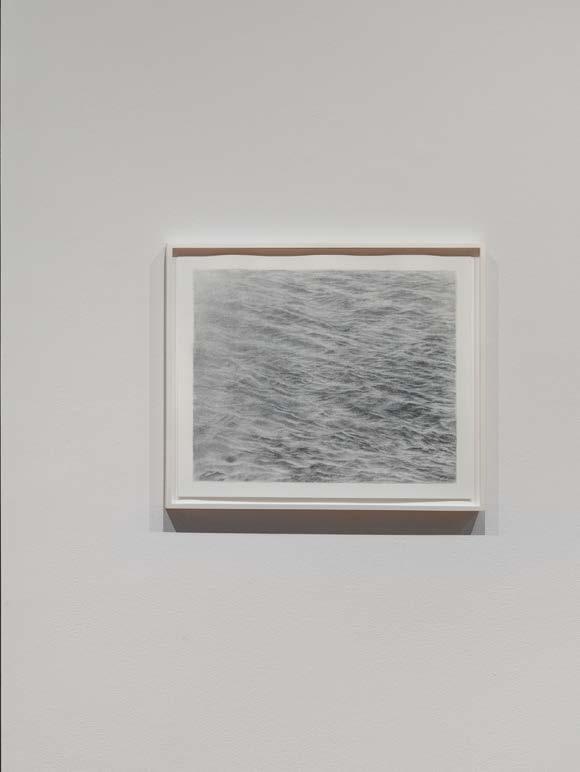
the mechanics of driving become almost unconscious so the music comes forward, I mediated on the drawings I had just seen, letting them appear in front of me like the answers in a Magic 8-Ball floating up through the dark blue liquid. Two drawings come up together, a seemingly random pair: one of Henri Michaux’s frenetic “mescaline drawings,” a buzzing net of lines, alongside one of Vija Celmins’s perfectly articulated drawings of the rumpled surface of the sea
[FIG. FIG X/X]. Was this a visual joke? The intersecting lines sort of resembled the image of volumetric waves, while at the same time appearing to be its opposite as an attitude toward drawing? I couldn’t see any clear reason to put these drawings together, so I pushed the pair away, making space for other drawings and ideas to come forward. I played “Jóga” again: All these accidents that happen / follow the dot / coincidence / makes sense…
After a few weeks of the Michaux-Celmins dyad idea nagging, I started to take it seriously. What would organizing a show around this pair teach me about them and about drawing at large? I’m not interested in exhibitions that illustrate an already-formulated thesis; as far as I’m concerned, the only reason to curate a show is to ask myself questions that can’t be posed or thought any other way—creating a place to think with things in space. And, given the

intention and breadth of the collection Shear put together, I decided that the show I would curate from it should take on its challenge, asking on some fundamental level, What is drawing?
And further, what are the possible modes that drawings could come into being? What are the criteria something called a drawing might address itself to from the perspective of a maker, a viewer, and the object? The dumbest difference between the Michaux and Celmins is that one is made of visible individual marks, while the other is made of tiny, almost imperceptible marks that blur into a surface. In the Michaux, made with ink, you can precisely follow every quick moment of the hand, as the small tremor-like gestures add up into an overall grid-like pattern; whereas in the Celmins the charcoal allows each stroke to almost disappear into the next, leaving the faintest impression of the hand—one that cannot be easily retraced, as if the artist has covered her tracks. The Michaux drawing appears to be parallel to the surface of the support, made in twodimensional alignment with the paper, while Celmins’s image seems to tilt at an angle, a receding plane. However, that distinction is complicated by the fact that Celmins’s drawing is not of the sea itself, but of a still image of the sea, and the way it is drawn emphasizes the allover-ness of the photographic object, rendering depth and volume similarly on the single plane of the surface.
Most interesting to me is the particular way each drawing engages time and presence. Michaux’s drawing makes an attempt to apprehend the visual and psychic effects of the hallucinogenic plant mescaline. It is a first-person drawing in the sense that it is using line to capture in real time a fleeting phenomenon, similar to the line of writing, that demarcates an autographic presence in the moment. Michaux used hallucinogens in an attempt to evacuate the self and explore a non-personal consciousness, so his drawing has the contradictory quality of being an immediate direct attempt at depicting an impersonal phenomenon of the mind. The effect is a visual trance. Celmins, on the other hand, takes an image of unceasing flux arrested through photography, so the undulant movement it depicts has been removed from time. But, in the particular way it is drawn, with unhurried methodical attention, it returns the static image a temporality of thinking or deep contemplation, which similarly seems aimed at a quality of mind beyond the self in a personal sense. Both of these works, in different ways, approach drawing as an activity coordinating the eye and hand in time, as a construction of consciousness made visible, external.
Placed side by side, the relation between these two drawings, with all their layered similarities and differences, is not resolvable. Together they formed a spark plug for approaching the exhibition that underscored form. It was by attending specifically to the surface of the drawings, the marks themselves, that I soon began to see the formal and conceptual implications of these two drawings ripple outward around the gallery, creating divergent paths that nevertheless meet and overlap. Alongside the Celmins I put one of her exquisite night skies [FIG. JS183]—an impenetrable image without a discernible mark in its velvety expanse—which I needed to then see alongside the exquisitely rendered volumes of Tom of Finland: polished asses and squeaking black leather [FIG. JS434]. The path of the surface, of the overall gestalt, could then move to the diaphanous volumes of Simeon Solomon’s Pre-Raphaelite heartthrobs [FIG. JS236], Robert Rauschenberg’s transfer rubbings [FIG. JS179], and finally dissolve at the far end into John Cage’s smudgy mists [FIG. JS528a, 528b], where touch has been even further attenuated by the printmaking process. As a continuous sweep, it moves from most to least control, from stone to air.
Tracking the other direction, the path of the individual mark, gesture, or line begins with the Michaux, moves to Jeff Koons’s crudely functional working drawing in ballpoint pen complete with measurements and notations [FIG. JS388], and then to another
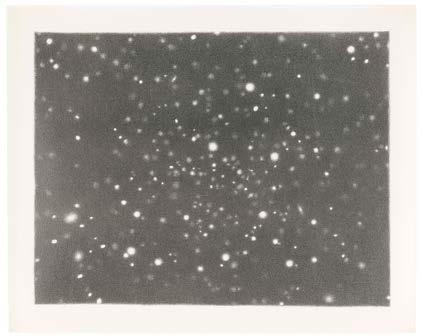
 JS434 Tom of Finland, Untitled, 1970.
JS434 Tom of Finland, Untitled, 1970.

 JS236 Simeon Solomon, The Annunciation, 1884. JS179 Robert Rauschenberg, Untitled, 1965.
JS236 Simeon Solomon, The Annunciation, 1884. JS179 Robert Rauschenberg, Untitled, 1965.
JS528a, 528b Ucidenihic tem estorrum excepelias maximi, sequam endi sim fugaaut hictinis et veliciant ex et dolorite solorrum quis aborist et od eum resequi.
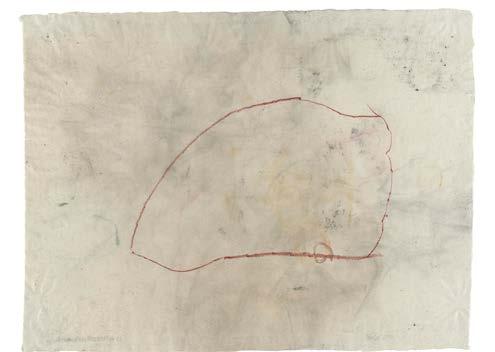

JS388 Jeff Koons, Untitled (Working Drawing for the Second Encased Doubledecker Sculpture, titled, “New Hoover Convertible, New Shelton, Wet/Dry, Doubledecker”), 1981.

loose preparatory sketch on graph paper, this one made by Balthus for his extraordinary painting Nude in Front of a Mantel (1955) [FIG. JS087]. As the line progresses it hardens, with contours becoming clearer and more definite, leading through Neoclassical Picasso [FIG. JS041] and Jean-Auguste-Dominique Ingres with a line that might as well be carved into diamond [FIG. JS025]. The abstraction increases, terminating in works of pure geometry and straight lines. The spectrum on this side moves from liquid flux to crystalline structure, or vice versa, depending on how you walk through.

The Drawing Center’s large gallery is divided down the middle by a row of cast iron columns—a dotted line that splits the space in half, allowing these two trajectories to be installed on either side of the room, right and left. However, I didn’t want to set up a linear progression or simple binary distinction for one to experience these drawings. Instead I was thinking of them as overlapping and simultaneous the way the things in a single room are typically understood. To this end, I divided the front-facing wall in half along the columns—one side dark gray and the other side pale gray—with the Michaux-Celmins pair straddling the divide. The long side-walls were painted in a gradient, going from dark to light by the time it gets to the other end, with the inverse, light to dark, on the other side, to create a sense that the space might be conceptually folded in on itself like a figure eight.
The two beautiful previous iterations of Ways of Seeing: Three Takes on the Jack Shear Drawing Collection, curated by Shear himself
 JS041 Pablo Picasso, La fille de la Marquise de Villarrautia (The Daughter of the Marquise de Villarrautia), 1918.
JS041 Pablo Picasso, La fille de la Marquise de Villarrautia (The Daughter of the Marquise de Villarrautia), 1918.
 JS025 Jean-Auguste-Dominique Ingres, Roger Freeing Angelica, c. 1830s.
JS025 Jean-Auguste-Dominique Ingres, Roger Freeing Angelica, c. 1830s.





and then by artist Arlene Shechet, both maximized the wall space and the vast collection with abundant, salon-style hangings. I decided to go in the other direction, paring the number of works to intensify the presence of each specific drawing and its set of relations around the room. I started to imagine the exhibition as an austere diagram with the almost punishing glamour of Last Year at Marienbad (1961), a film that sought to “approach the complexity of thought, of its processes” in endless unanswerable questions.1 To this end and to more directly pose my own questions about the nature of drawing, I limited my selection to works to do not deal with color, keeping everything in the main gallery on a single horizon: mark making. To underscore this point, the slim back gallery, divided into two halves with pale violet and light yellow walls, contained drawings in which color was the structural element, showing how distinctions in hue invert and undermine the visual terms that were set up in the main gallery.
Of course, artworks are not only about how they are made. The way a drawing looks is the materialization of an intention, the emanation of a worldview. Putting drawings side by side, strictly ordered by their marks and surface, tells us very little about the subject matter, while perhaps revealing something about their content. These works communicate their own meanings, speaking in different voices of vastly different experiences, within the nuance of a common pictorial language. In the gallery the peculiar experience of shifting one’s attention between an individual drawing and an awareness of its place in the larger order of the installation—an oscillation between micro and macro cosmic attention—is much like the effect of being enshrined in a car surrounded by good music as the countryside undulates outside. Emotional landscapes / they pass over me / confuse. Drawing isn’t driving, but it is worth entertaining, for a moment, the idea of their mutual capacity for thinking and feeling, and giving shape. An intertwining of consciousness and the world. The exhibition seeks drawing as a vehicle of conscious, always in route. A kind of becoming: state of emergency / is where I want to be / state of emergency / how beautiful to be.
Works in the Exhibition
Emma Kunz
Werk Nr. 079, n.d.
Pencil and color pencil on graph paper
41 5/16 x 39 3/8 inches (104.9 x 100 cm)
Pablo Picasso
La fille de la Marquise de Villarrautia (The Daughter of the Marquise de Villarrautia), 1918
Graphite on paper
14 9/16 x 10 5/8 inches (37 x 27 cm)
Hashimoto Sadahide (Utagawa
Sadahide) (signed under the moniker
Hashimoto Gyokuran)
The opposing forces ford a river towards troop in formation on bank (Prepatory drawing for a triptych of a battle scene), c. 1847–48
Black ink on paper
15 x 30 inches (38.1 x 76.2 cm)
Giorgio Vasari
The Virgin and Child with the Infant Saint John the Baptist and Saint Elizabeth, c. 1540s
Brown ink and black chalk on paper
8 1/2 x 7 3/4 inches (21.6 x 19.7 cm)
Jean-Auguste-Dominique Ingres
Roger Freeing Angelica, c. 1830s
Pencil on tracing paper, squared in pencil
18 7/8 x 15 inches (47.7 x 38.2 cm)
Jean-Auguste-Dominique Ingres
Christ on the Mountain, 1860
Pen and brown ink and gray wash over pencil, within brown ink framing lines, the sheet faintly squared for transfer in pencil
14 x 13 1/2 inches (35.6 x 34.3 cm)
Balthus
Two Studies for Nu devant la cheminée (recto and verso), 1954
Pencil on gridded paper (recto); pencil on paper (verso)
11 3/4 x 7 3/4 inches (29.8 x 19.7 cm)
Egon Schiele
Self-portrait, 1912
Pencil on paper
18 11/16 x 12 5/16 inches (47.5 x 31.3 cm)
Jean Cocteau
Querelle de Brest, 1947
Graphite on paper
8 x 6 inches (20.3 x 15.2 cm)
Ellsworth Kelly
Sunflower, 1983
Graphite on paper
22 x 30 inches (55.9 x 76.2 cm)
Nayland Blake
1.7.15, 2015
Graphite on paper
Philip Guston
Head and Smoke, 1974
Black ink on paper
18 7/8 x 23 5/8 inches (47.9 x 60 cm)
Willem de Kooning
Figure on a Beach, 1958
Black ink on paper
17 x 14 inches (43.2 x 35.6 cm)
Balthus
Study for Nu au chat, 1948
Pencil on paper
12 5/8 x 9 5/8 inches (32.1 x 24.4 cm)
Balthus
Study for La Patience (recto); Two Studies for Les Beaux Jours (verso), 1943
Pencil on paper
7 7/8 x 7 7/8 inches (20 x 20 cm)
Jeff Koons
Untitled (Working Drawing for the Second Encased Doubledecker Sculpture, titled, “New Hoover Convertible, New Shelton, Wet/Dry, Doubledecker”), 1981
Ballpoint pen on paper
11 x 8 1/2 inches (27.9 x 21.6 cm)
Willem de Kooning
Untitled (Composition with Figures), c.
1975
Graphite on paper
14 x 16 7/8 inches (35.6 x 42.9 cm)
Henri Michaux
Sans titre (Untitled), c. 1955–59
Black ink on paper
12 1/2 x 9 1/2 inches (31.8 x 24.1 cm)
Vija Celmins
Untitled (Ocean), 2014
Charcoal on acrylic ground on paper
15 1/4 x 18 1/2 inches (39 x 47 cm)
Vija Celmins
Galaxy (Hydra), 1974
Graphite on acrylic ground on paper
12 x 14 7/8 inches (30.5 x 37.8 cm)
Tom of Finland
Untitled, 1967
Graphite on paper
12 x 8 7/8 inches (30.5 x 22.5 cm)
Tom of Finland
Untitled, 1970
Graphite on paper
8 3/4 x 6 3/4 inches (22.2 x 17.1 cm)
Simeon Solomon
The Annunciation, 1884
Pencil with stump on paper
14 7/8 x 21 7/8 inches (37.8 x 55.6 cm)
Giovanni Domenico Tiepolo
Hercules and Antaeus, c. 18th century
Pen and gray and black ink and gray wash over black chalk on paper
8 1/2 x 5 3/4 inches (21.5 by 14.5 cm)
Jean-Auguste-Dominique Ingres
Portrait of Alexis-René Le Go, 1836
Graphite on paper
11 7/8 x 8 3/4 inches (30.2 x 22.2 cm)
William Blake
The Death of Ezekiel’s Wife, c. 1785 Black ink with transparent and opaque watercolor over graphite on paper
13 3/8 x 18 5/8 inches (34 x 47.3 cm)
Edward Coley Burne-Jones
S. Mary Magdalene the Morning of the Resurrection, 1886
Graphite on paper
12 x 7 inches (30.5 x 17.8 cm)
Simeon Solomon
Three Heads, c. 1885
Red chalk on artist’s board
18 3/8 x 23 1/4 inches
Jean-Baptiste Millet
Les Moissans, n.d.
Charcoal on paper
12 1/2 x 14 inches (31.8 x 35.6 cm)
Odilon Redon
A Man Standing on Rocks Beside the Sea, c. 1868
Graphite on paper
10 3/4 x 8 3/4 inches (27.3 x 22.2 cm)
Robert Gober
Untitled, 2017
Graphite and color pencil on vellum
12 x 9 inches (30.5 x 22.9 cm)
Balthus Study for Guitar Lesson, 1934
Graphite on paper
7 7/8 x 12 inches (20 x 30.5 cm)
Pavel Tchelitchew
Figures in the Mountains, 1942
Ink wash on paper
14 1/2 x 11 1/2 inches (36.8 x 29.2 cm)
Jean-Honoré Fragonard
The Miraculous Draught of Ruggiero and Alcina (Orlando furioso, VII, 32), c. 1780–85
Black chalk with opaque and transparent
watercolor on paper
15 7/8 x 10 1/4 inches (40.3 x 26 cm)
Gustave Doré
Study for La Mort D’Orphée, 1879
Charcoal and watercolor with gouache highlights on paper laid down on thick card
20 1/2 x 31 1/2 inches (52.1 x 80 cm)
Robert Rauschenberg
Untitled, 1965
Solvent transfer, graphite, crayon, watercolor, and paint on paper
14 1/8 x 20 inches (35.9 x 50.8 cm)
Gerhard Richter
Abstract VII 91, 1991
Ink on paper
9 1/4 x 13 inches (23.5 x 33 cm)
Mark Tobey
Lights, 1954
Tempera on Japan mounted on card
8 1/2 x 17 3/4 inches (21.6 x 45.1 cm)
Brice Marden
Untitled, 1971
Graphite on paper
28 7/8 x 20 3/4 inches (73.3 x 52.7 cm)
Ivan Kliun
Composition with Circle, 1921
Gouache on paper
10 3/4 x 8 1/2 inches (27.3 x 21.6 cm)
Simeon Solomon
Woman with Blue Wreath, c. 1869
Blue pencil with gum Arabic on artist’s board
14 13/16 x 13 inches (37.6 x 33 cm)
Christopher Wilmarth
The Whole Soul Summed Up, 1979
Transparent watercolor, charcoal, and graphite on paper
31 1/4 x 22 1/2 inches (79.4 x 57.2 cm)
James Lee Byars
247D, 1996
Gold pencil on red paper
30 x 11 inches (76.2 x 27.9 cm)
Henri Michaux
Sans titre (Untitled), 1954
Opaque and transparent watercolor on paper
17 3/8 x 22 inches (44.1 x 55.9 cm)
Anne Ryan
M1044D#183, c. 1950 Collage on cardboard
7 1/2 x 6 inches (19.1 x 15.2 cm)
Sol LeWitt
Red Grid, Yellow Circles, Black Arcs from Four Sides and Blue Arcs from Four Corners, 1972 Ink and graphite on paper
17 x 17 inches (43.2 x 43.2 cm)
Odilon Redon
Nature morte, 1861
Watercolor, gouache, and graphite on paper
21 3/8 x 18 inches (54.3 x 45.7 cm)
Chris Ofili
Afromuses (Couple), 2005
Watercolor and graphite on paper
19 x 12 1/4 inches (48.3 x 31.1 cm)
Chris Ofili
Afromuses (Couple), 2005
Watercolor and graphite on paper
19 x 12 1/2 inches (48.3 x 31.8 cm)
Arshile Gorky
Untitled (Mural Study?), c. 1938–42
Charcoal and pastel on paper
19 x 24 1/2 inches (48.3 x 62.2 cm)
Stanley Whitney
Untitled, 2020
Crayon and graphite on Japanese paper
12 1/2 x 17 inches (31.8 x 43.2 cm)
Julie Mehretu
Untitled, 2000
Ink and color pencil on vellum laid on paper
19 x 24 inches (48.3 x 61 cm)
Gladys Nilsson
Physically Outfyted, 1968
Watercolor on paper
30 1/4 x 22 1/2 inches (76.8 x 57.2 cm)
Walter Price
Scarecrow, 2020
Graphite, gel pen, Scotch tape, burned paper, color pencil, and Sharpie on manila tagboard paper
12 x 9 inches (30.5 x 22.9 cm)
Paul Cadmus
Study for David and Goliath #D, 1971
Crayons on tracing paper
14 3/4 x 17 3/4 inches (37.5 x 45.1 cm)
Unknown, (Indian School)
Magical Concentration Pentagram, n.d.
Ink and gouache on paper in original
frame
10 x 10 inches (25.4 x 25.4 cm)
Gabriel Orozco
Fear Not, 2001
Collage, acrylic, and ink on paper
11 x 8 1/2 inches (27.9 x 21.6 cm)
Joseph Stella
Coleus, n.d.
Pencil and crayon on paper
20 1/4 x 13 1/2 inches (51.4 x 34.3 cm)
Claes Oldenburg Drum Pedal, 1973
Watercolor on Paper
29 1/8 x 23 inches (74 x 58.4 cm)
Vija Celmins
Untitled (Ham Hock), 1964
Gouache and graphite on paper
20 1/2 x 22 inches (52.1 x 55.9 cm)
Rosemarie Trockel
Untitled, n.d.
Pencil and watercolor on paper
7 7/8 x 5 1/8 inches (20 x 13 cm)
Nayland Blake
11.28.15, 2015
Color pencil on paper
16 x 12 1/2 inches (40.6 x 31.8 cm)
Writer and curator Jarrett Earnest has contributed criticism and long form interviews to publications including What it Means to Write About Art: Interviews with Art Critics (David Zwirner Books, 2018), The Brooklyn Rail, Vulture, The Village Voice, Los Angeles Review of Books, Art in America, Art Practical, Riot of Perfume, SFAQ, The Miami Rail, Cultured, Elephant, New York Magazine, diSONARE, and many exhibition catalogs. He has recently curated exhibitions including The Young and the Evil at David Zwirner, NY (February 21–April 13, 2019) and Closer as Love: Polaroids 1993–2007: Breyer P-Orridge at Nina Johnson, Miami (October 3–November 23, 2019). Earnest was also the editor of Hot, Cold, Heavy, Light: 100 Art Writings 1988–2017 by Peter Schjeldahl (Abrams, June 2019), TELL ME
SOMETHING GOOD: Artist Interviews from the Brooklyn Rail (with Lucas Zwirner; David Zwirner Books, 2017), and FORBILL, ANYTHING: Words and Images for Bill Berkson (with Isabelle Sorrell; Pressed Wafer, 2015).
Claire Gilman is Chief Curator at The Drawing Center.
Jack Shear is a photographer, curator, and art collector living and working in Spencertown, NY. He previously collaborated with Anne Philbin on The Drawing Center exhibition Drawn from Artists’ Collections (1999), and he cocurated Twice Drawn (2006) at the Tang Teaching Museum with Director Ian Berry. Shear’s collection has previously featured in exhibitions at the Tang Teaching Museum and the Blanton Museum of Art. His own photographs are in the collections of the San Francisco Museum of Modern Art and the Whitney
Museum of American Art. Shear is also President of the Ellsworth Kelly Foundation and serves on the Drawings & Prints Committee at the Museum of Modern Art.
Arlene Shechet is a multidisciplinary sculptor living and working in New York City and the Hudson Valley. A criticallyacclaimed twenty-year survey of Shechet’s work, All At Once, was on view at the Institute of Contemporary Art/ Boston in 2015. Shechet has designed and curated exhibitions including Porcelain, No Simple Matter: Arlene Shechet and the Arnhold Collection, on view at The Frick Collection, New York (2016–17), and From Here on Now at The Phillips Collection, Washington, DC (2016–17). Her ambitious large-scale public project Full Steam Ahead featured monumental porcelain and mixed media sculptures installed in Madison Square Park, New York (2018–19). Shechet’s first solo show at Pace Gallery, Skirts, opened in New York in February 2020, accompanied by the publication of the monograph Arlene Shechet: Skirts. Upcoming projects include exhibitions in Hong Kong and Los Angeles as well as a historical and contemporary installation that Shechet has designed for the Harvard Art Museums and a permanent sculpture commission for the Stuart Collection at the University of California San Diego.
Co-Chairs
Andrea Crane
Amy Gold
Treasurer
Stacey Goergen
Secretary
Dita Amory
Frances Beatty Adler
Valentina Castellani
Brad Cloepfil
Harry Tappan Heher
Priscila Hudgins
Rhiannon Kubicka
Iris Z. Marden
Adam Pendleton
David M. Pohl
Nancy Poses
Eric Rudin
Almine Ruiz-Picasso
Jane Dresner Sadaka
David Salle
Curtis Talwst Santiago
Joyce Siegel
Amy Sillman
Galia Meiri Stawski
Rirkrit Tiravanija
Barbara Toll
Jean-Edouard van Praet d’Amerloo
Waqas Wajahat
Isabel Stainow Wilcox
Linda Yablonsky
Emeritus
Eric Rudin
Laura Hoptman Executive Director
Olga Valle Tetkowski Deputy Director
Rebecca Brickman Director of Development
Aimee Good Director of Education and Community Programs
Allison Underwood Director of Communications
Claire Gilman Chief Curator
Rosario Güiraldes Associate Curator
Isabella Kapur Curatorial Associate
Kate Robinson Registrar
Dan Gillespie Operations Manager
Tiffany Shi Development Manager
Kara Nandin Digital Content Coordinator
Rebecca DiGiovanna
Assitant to the Office of the Executive Director
Nadia Parfait
Visitor Services Associate
Lucia Zezza
Bookstore Manager
Mark Zubrovich
Visitor Services Associate
All artworks pictured in this volume are from the Jack Shear Collection and have been reproduced by permission of the individual artists and/or their representatives. Additional image caption and copyright information is as follows:
Cover TKTKTKT
Published on the occasion of the exhibition Ways of Seeing: Three Takes on the Jack Shear Drawing Collection
Organized by Claire Gilman, The Drawing Center’s Chief Curator, with curators Jack Shear, Arlene Shechet, and Jarrett Earnest, with Isabella Kapur, Curatorial Associate
The Drawing Center October 2, 2021–February 20, 2022
Generous funding for Ways of Seeing: Three Takes on the Jack Shear Drawing Collection is provided by Kathy and Richard Fuld, Agnes Gund, the Low Road Foundation, Matthew Marks, Christie’s, Emily Rauh Pulitzer, Jo Carole and Ronald S. Lauder, and Pace Gallery.
This is number 146 of the Drawing Papers, a series of publications documenting The Drawing Center’s exhibitions and programs and providing a forum for the study of drawing.
Editor
Joanna Ahlberg
Design
Dandelion
Printing & Binding
Shapco Printing, Minneapolis
About the Type
This book is set in Publico Text (Roman, Italic, and Bold) It is part of the Publico Collection, designed by Ross Milne, Christian Schwartz, Paul Barnes, Kai Bernau, and Greg Gazdowicz, and released incrementally by Commercial Type in 2009, 2013, and 2014. This book also uses Plain (Regular and Italic), which was designed by François Rappo and released by Optimo Type Foundry in 2014.
ISBN 978-0-9423XX-XX-X
© 2022 The Drawing Center
All rights reserved. No part of this publication may be reproduced in any form without written permission from The Drawing Center.
ISBN 978-094232XXXX
780942 32XXXX